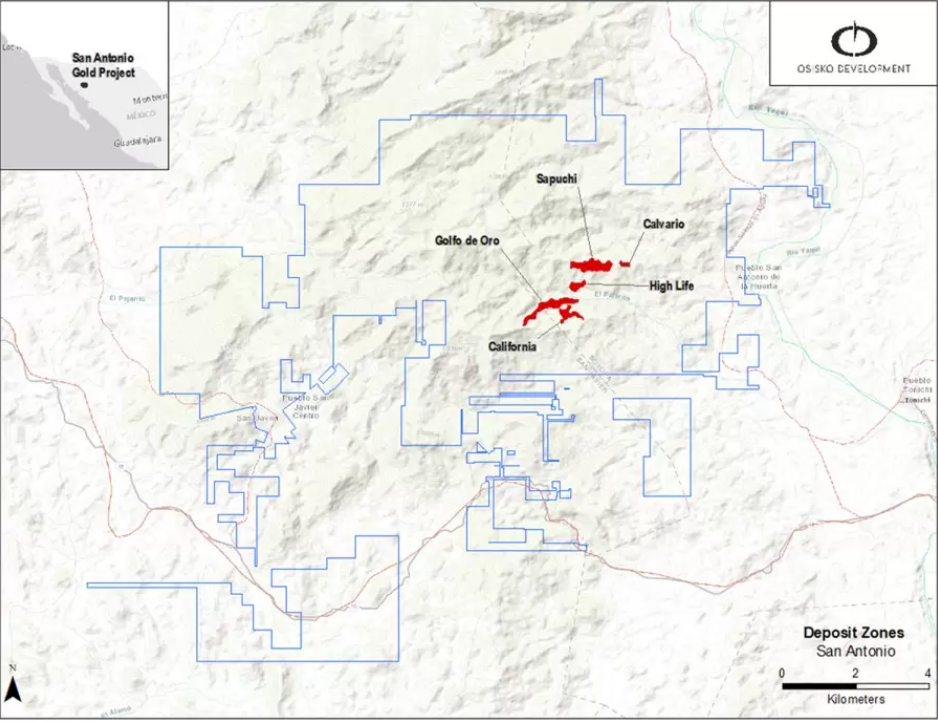
Osisko Development (TSXV:ODV) has announced that an initial open-pit resource estimate has been completed for the Sapuchi, California, Golfo de Oro, Calvario, and High Life deposits at the San Antonio project. The project is located in Sonora State, Mexico and is characterized by a hydrothermal breccia that forms an approximately 3000 metre-long east-northeast trending mineralization corridor with the Luz del Cobre copper deposit to the east.
Chris Lodder, President of Osisko Development commented in a press release: “The addition of this new resource further strengthens our portfolio for near term advancement and towards possible production. Osisko Development has made considerable progress at San Antonio in the past year with the construction of the leach pad, near term processing of the stockpile and completion of a drill program to generate this initial resource. The Company believes there is potential to add to the mineral resource through continued exploration and drilling on the property.”
Highlights from the mineral resource estimate are as follows:
- 576,000 oz of Au and 1.37 M oz Ag Indicated and
- 544,000 oz Au and 1.76 M oz of Ag Inferred
San Antonio Project Mineral Resource
- Indicated Mineral Resource of 576,000 ounces of gold and 1.37 million ounces of silver (14.9 million tonnes grading 1.2 g/t Au and 2.9 g/t Ag).
- Inferred Mineral Resource of 544,000 ounces of gold and 1.76 million ounces of silver (16.6 million tonnes grading 1.0 g/t Au and 3.3 g/t Ag).
- Mineral resource comprises oxide, transition and sulphide zones for each deposit using 0.27 g/t Au cut-off grade for oxide and 0.44 g/t Au cut-off grade for transition and sulphide and a 50-degree pit slope.
- The 2022 Mineral Resource Estimate (“MRE”) covers a portion of the Sapuchi – Cero Verde trend that encompasses five deposits: Sapuchi, Golfo de Oro, California, Calvario and High Life over approximately 2.8 km along strike, a maximum width of 600 metres (m) to a maximum depth of 300 m below surface.
- The MRE is based on 84,454 m of current and verified historic drilling in 579 holes, of which 27,870 m of drilling in 177 holes were drilled by the Company in 2021.
- Gold mineralization is hosted within altered hydrothermal breccia and sediments, as stockwork quartz veins and veinlets, adjacent to intrusions and fault structures and often associated with iron carbonate minerals.
- Resource summary and sensitivity tables are presented in the tables below.
The MRE incorporates five deposits, Sapuchi, California, Golfo de Oro, High Life and Calvario, as part of what comprises 2.8 km of the 10.0 km within the Sapuchi-Cero Verde trend of the San Antonio Project (Figure 1). The deposits are in the indicated and inferred categories listed in Table 1 and a further breakdown by deposit and oxide zone are listed in the Tables 2 and 4. Grade sensitivity is presented in Table 3. Potential mining scenarios indicate a strip ratio of 1.0 to 6.7. The MRE was conducted by Talisker Exploration Services Inc., under the supervision of Servicios Geológicos IMEx, S.C and Micon International Limited.
The deposits are constrained within a geologic model of the hydrothermal breccia, the main mineralization control known to date. Additional drill targets remain underexplored on the property and new exploration drilling is recommended to verify historic data and potentially add new resource. Further infill and exploration drilling is recommended on the Project.
Operational Update
The San Antonio Project gold mineralization is characterized by hydrothermal breccia that forms an approximately 3,000 m long east-northeast trending mineralization corridor with the Luz del Cobre copper deposit at the east. The gold mineralization is associated with intense chlorite and carbonate alteration and is intrusion related with host sedimentary rocks. The breccia has been defined to a vertical depth of 500 m and at an average depth of 250 m. Drilling has occurred within the three major zones at Sapuchi, Golfo de Oro and California, over a combined strike length of 1 km of the 3 km breccia trend.
Since Osisko Development’s acquisition of the San Antonio Project in November 2020, the Company has successfully achieved the following operational milestones
- The construction of a leach pad and carbon in column plant at the end of 2021 to process stockpiled mineralized material.
- The stockpile has a total of 1.1 M tonnes with an average grade of 0.57 g/t Au.
- The processing of the stockpile began in Q4 2021 and currently, 680,000 tonnes of mineralized material has been placed and processed.
Table 1: 2022 San Antonio Project Mineral Resource Estimate for an open pit scenario- all deposits indicated category
| INDICATED | ||||||
| Deposit | Weathering
Zone |
Tonnes
(Mt) |
Au
(g/t) |
Ag
(g/t) |
Au
Ounces (000) |
Ag
Ounces (000,000) |
| California | Oxide | 0.6 | 0.93 | 2.8 | 17 | 0.05 |
| Transition | 0.2 | 0.79 | 3.3 | 6 | 0.02 | |
| Sulphide | 3.1 | 1.31 | 2.4 | 130 | 0.23 | |
| Total | 3.9 | 1.22 | 2.5 | 153 | 0.31 | |
| Golfo de Oro | Oxide | 0.2 | 1.07 | 2.8 | 7 | 0.02 |
| Transition | 0.1 | 1.19 | 2.8 | 6 | 0.01 | |
| Sulphide | 5.3 | 1.46 | 2.5 | 249 | 0.42 | |
| Total | 5.7 | 1.44 | 2.5 | 262 | 0.46 | |
| Sapuchi | Oxide | 1.9 | 0.85 | 3.6 | 53 | 0.22 |
| Transition | 1.4 | 1.04 | 3.6 | 47 | 0.16 | |
| Sulphide | 2.1 | 0.94 | 3.4 | 62 | 0.22 | |
| Total | 5.4 | 0.93 | 3.5 | 162 | 0.61 | |
| Total | Oxide | 2.7 | 0.89 | 3.4 | 77 | 0.30 |
| Transition | 1.8 | 1.02 | 3.5 | 59 | 0.20 | |
| Sulphide | 10.4 | 1.31 | 2.6 | 441 | 0.88 | |
| Total | 14.9 | 1.20 | 2.9 | 576 | 1.37 | |
Table 2: 2022 San Antonio Project Mineral Resource Estimate for an open pit scenario- all deposits inferred category
| INFERRED | ||||||
| Deposit | Weathering
Zone |
Tonnes
(Mt) |
Au
(g/t) |
Ag
(g/t) |
Au
Ounces (000) |
Ag
Ounces (000,000) |
| California | Oxide | 0.4 | 0.68 | 2.1 | 8 | 0.02 |
| Transition | 0.1 | 0.85 | 2.6 | 4 | 0.01 | |
| Sulphide | 1.1 | 1.27 | 3.8 | 46 | 0.14 | |
| Total | 1.6 | 1.10 | 3.3 | 58 | 0.17 | |
| Golfo de Oro | Oxide | 0.5 | 0.80 | 3.0 | 12 | 0.04 |
| Transition | 0.2 | 0.93 | 3.4 | 5 | 0.02 | |
| Sulphide | 5.7 | 1.29 | 2.5 | 237 | 0.46 | |
| Total | 6.4 | 1.24 | 2.5 | 254 | 0.52 | |
| High Life | Oxide | 0.5 | 0.84 | 4.2 | 14 | 0.07 |
| Transition | 0.2 | 0.73 | 4.5 | 4 | 0.02 | |
| Sulphide | 0.1 | 0.90 | 8.3 | 4 | 0.04 | |
| Total | 0.8 | 0.83 | 4.9 | 22 | 0.13 | |
| Sapuchi | Oxide | 3.2 | 0.74 | 3.7 | 75 | 0.37 |
| Transition | 1.6 | 0.92 | 3.6 | 48 | 0.19 | |
| Sulphide | 2.8 | 0.92 | 4.1 | 84 | 0.37 | |
| Total | 7.6 | 0.85 | 3.8 | 208 | 0.94 | |
| Calvario | Oxide | 0.1 | 0.53 | 0.0 | 2 | 0.00 |
| Transition | 0.0 | 0.55 | 0.0 | 0.0 | 0.00 | |
| Sulphide | 0.0 | 0.0 | 0.0 | 0.0 | 0.00 | |
| Total | 0.1 | 0.53 | 0.0 | 2 | 0.00 | |
| Total | Oxide | 4.6 | 0.74 | 3.5 | 111 | 0.51 |
| Transition | 2.1 | 0.90 | 3.6 | 61 | 0.24 | |
| Sulphide | 9.8 | 1.18 | 3.2 | 371 | 1.00 | |
| Total | 16.6 | 1.02 | 3.3 | 544 | 1.76 | |
Table 3: San Antonio Project Mineral Resource Estimate for an open pit scenario, all deposits separated by oxide zone.
| Category | Zone | Tonnes
(Mt) |
Au
(g/t) |
Ag
(g/t) |
Au
Ounces (000) |
Ag
Ounces (000,000) |
| Indicated | Oxide | 2.7 | 0.89 | 3.4 | 77 | 0.30 |
| Transition | 1.8 | 1.02 | 3.5 | 59 | 0.20 | |
| Sulphide | 10.4 | 1.31 | 2.6 | 441 | 0.88 | |
| Total | 14.9 | 1.20 | 2.9 | 576 | 1.37 | |
| Inferred | Oxide | 4.6 | 0.74 | 3.5 | 111 | 0.51 |
| Transition | 2.1 | 0.90 | 3.6 | 61 | 0.24 | |
| Sulphide | 9.8 | 1.18 | 3.2 | 371 | 1.00 | |
| Total | 16.6 | 1.02 | 3.3 | 544 | 1.76 |
Table 4: San Antonio Project Cut-Off Gold Price Sensitivity Table (Base cases in Bold), Indicated Category
| Sensitivity to Gold Price INDICATED | |||||||
| Gold
Price US$/oz |
Cut-off
Grade (g/t) |
Weathering
Zone |
Tonnes
(Mt) |
Au
(g/t) |
Ag
(g/t) |
Au
Ounces (000) |
Ag
Ounces (000,000) |
| 1400 | 0.34 | Oxide | 2.6 | 0.90 | 3.4 | 76 | 0.29 |
| 0.55 | Transition | 1.6 | 1.07 | 3.6 | 55 | 0.18 | |
| 0.55 | Sulphide | 8.0 | 1.44 | 2.8 | 372 | 0.72 | |
| Total | 12.3 | 1.28 | 3.0 | 504 | 1.19 | ||
| 1450 | 0.33 | Oxide | 2.6 | 0.90 | 3.4 | 76 | 0.29 |
| 0.54 | Transition | 1.6 | 1.06 | 3.5 | 56 | 0.19 | |
| 0.54 | Sulphide | 8.2 | 1.43 | 2.8 | 377 | 0.73 | |
| Total | 12.5 | 1.27 | 3.0 | 510 | 1.21 | ||
| 1500 | 0.32 | Oxide | 2.7 | 0.90 | 3.4 | 77 | 0.29 |
| 0.52 | Transition | 1.7 | 1.05 | 3.5 | 57 | 0.19 | |
| 0.52 | Sulphide | 9.0 | 1.40 | 2.7 | 404 | 0.78 | |
| Total | 13.3 | 1.25 | 3.0 | 537 | 1.27 | ||
| 1550 | 0.31 | Oxide | 2.7 | 0.89 | 3.4 | 77 | 0.29 |
| 0.50 | Transition | 1.7 | 1.05 | 3.5 | 57 | 0.19 | |
| 0.50 | Sulphide | 9.3 | 1.38 | 2.7 | 411 | 0.80 | |
| Total | 13.6 | 1.24 | 2.9 | 545 | 1.29 | ||
| 1600 | 0.30 | Oxide | 2.7 | 0.89 | 3.4 | 77 | 0.29 |
| 0.48 | Transition | 1.7 | 1.04 | 3.5 | 58 | 0.20 | |
| 0.48 | Sulphide | 9.6 | 1.37 | 2.7 | 420 | 0.83 | |
| Total | 14.0 | 1.23 | 2.9 | 554 | 1.31 | ||
| 1650 | 0.29 | Oxide | 2.7 | 0.89 | 3.4 | 77 | 0.29 |
| 0.47 | Transition | 1.8 | 1.03 | 3.5 | 58 | 0.20 | |
| 0.47 | Sulphide | 9.8 | 1.35 | 2.7 | 426 | 0.84 | |
| Total | 14.3 | 1.22 | 2.9 | 561 | 1.33 | ||
| 1700 | 0.28 | Oxide | 2.7 | 0.89 | 3.4 | 77 | 0.29 |
| 0.46 | Transition | 1.8 | 1.02 | 3.5 | 58 | 0.20 | |
| 0.46 | Sulphide | 10.1 | 1.33 | 2.6 | 432 | 0.86 | |
| Total | 14.5 | 1.21 | 2.9 | 567 | 1.35 | ||
| 1750 | 0.27 | Oxide | 2.7 | 0.89 | 3.4 | 77 | 0.30 |
| 0.44 | Transition | 1.8 | 1.02 | 3.5 | 59 | 0.20 | |
| 0.44 | Sulphide | 10.4 | 1.31 | 2.6 | 441 | 0.88 | |
| Total | 14.9 | 1.20 | 2.9 | 576 | 1.37 | ||
| 1800 | 0.27 | Oxide | 2.7 | 0.89 | 3.4 | 77 | 0.30 |
| 0.43 | Transition | 1.8 | 1.02 | 3.5 | 59 | 0.20 | |
| 0.43 | Sulphide | 10.6 | 1.30 | 2.6 | 446 | 0.89 | |
| Total | 15.1 | 1.20 | 2.9 | 582 | 1.39 | ||
| 1850 | 0.26 | Oxide | 2.7 | 0.89 | 3.4 | 77 | 0.30 |
| 0.42 | Transition | 1.8 | 1.01 | 3.5 | 59 | 0.20 | |
| 0.42 | Sulphide | 10.9 | 1.30 | 2.6 | 455 | 0.91 | |
| Total | 15.4 | 1.19 | 2.8 | 591 | 1.41 | ||
| 1900 | 0.25 | Oxide | 2.7 | 0.89 | 3.4 | 77 | 0.30 |
| 0.41 | Transition | 1.8 | 1.01 | 3.5 | 59 | 0.20 | |
| 0.41 | Sulphide | 11.0 | 1.29 | 2.6 | 457 | 0.92 | |
| Total | 15.6 | 1.18 | 2.8 | 593 | 1.42 | ||
Table 5: San Antonio Project Cut-Off Gold Price Sensitivity Table (Base cases in Bold), Inferred Category
| Sensitivity to Gold Price INFERRED | |||||||
| Gold
Price US$/oz |
Cut-off
Grade (g/t) |
Weathering
Zone |
Tonnes
(Mt) |
Au
(g/t) |
Ag
(g/t) |
Au
Ounces (000) |
Ag
Ounces (000,000) |
| 1400 | 0.34 | Oxide | 3.9 | 0.81 | 3.7 | 103 | 0.47 |
| 0.55 | Transition | 1.6 | 1.00 | 3.9 | 52 | 0.20 | |
| 0.55 | Sulphide | 5.9 | 1.38 | 3.5 | 261 | 0.67 | |
| Total | 11.4 | 1.13 | 3.6 | 416 | 1.34 | ||
| 1450 | 0.33 | Oxide | 4.1 | 0.79 | 3.7 | 104 | 0.48 |
| 0.54 | Transition | 1.7 | 0.98 | 3.8 | 54 | 0.21 | |
| 0.54 | Sulphide | 6.7 | 1.33 | 3.5 | 286 | 0.75 | |
| Total | 12.5 | 1.11 | 3.6 | 444 | 1.44 | ||
| 1500 | 0.32 | Oxide | 4.2 | 0.78 | 3.6 | 105 | 0.48 |
| 0.52 | Transition | 1.8 | 0.96 | 3.7 | 56 | 0.22 | |
| 0.52 | Sulphide | 7.6 | 1.29 | 3.4 | 314 | 0.83 | |
| Total | 13.6 | 1.09 | 3.5 | 475 | 1.53 | ||
| 1550 | 0.31 | Oxide | 4.3 | 0.77 | 3.6 | 107 | 0.49 |
| 0.50 | Transition | 1.9 | 0.94 | 3.7 | 58 | 0.23 | |
| 0.50 | Sulphide | 8.1 | 1.26 | 3.3 | 330 | 0.87 | |
| Total | 14.3 | 1.07 | 3.5 | 494 | 1.59 | ||
| 1600 | 0.30 | Oxide | 4.4 | 0.76 | 3.5 | 109 | 0.50 |
| 0.48 | Transition | 2.0 | 0.93 | 3.7 | 59 | 0.23 | |
| 0.48 | Sulphide | 8.5 | 1.24 | 3.3 | 339 | 0.90 | |
| Total | 14.9 | 1.06 | 3.4 | 506 | 1.63 | ||
| 1650 | 0.29 | Oxide | 4.5 | 0.76 | 3.5 | 110 | 0.50 |
| 0.47 | Transition | 2.0 | 0.93 | 3.7 | 59 | 0.23 | |
| 0.47 | Sulphide | 8.9 | 1.22 | 3.3 | 348 | 0.93 | |
| Total | 15.4 | 1.10 | 3.3 | 517 | 1.67 | ||
| 1700 | 0.28 | Oxide | 4.6 | 0.75 | 3.4 | 111 | 0.51 |
| 0.46 | Transition | 2.0 | 0.91 | 3.6 | 60 | 0.24 | |
| 0.46 | Sulphide | 9.3 | 1.20 | 3.2 | 360 | 0.97 | |
| Total | 16.0 | 1.03 | 3.3 | 531 | 1.72 | ||
| 1750 | 0.27 | Oxide | 4.6 | 0.74 | 3.4 | 111 | 0.51 |
| 0.44 | Transition | 2.1 | 0.90 | 3.6 | 61 | 0.24 | |
| 0.44 | Sulphide | 9.8 | 1.18 | 3.2 | 371 | 1.00 | |
| Total | 16.6 | 1.02 | 3.3 | 544 | 1.76 | ||
| 1800 | 0.27 | Oxide | 4.8 | 0.73 | 3.3 | 114 | 0.52 |
| 0.43 | Transition | 2.2 | 0.89 | 3.6 | 62 | 0.25 | |
| 0.43 | Sulphide | 10.4 | 1.15 | 3.1 | 386 | 1.04 | |
| Total | 17.4 | 1.00 | 3.2 | 562 | 1.81 | ||
| 1850 | 0.26 | Oxide | 4.9 | 0.73 | 3.3 | 114 | 0.52 |
| 0.42 | Transition | 2.2 | 0.89 | 3.5 | 63 | 0.25 | |
| 0.42 | Sulphide | 10.9 | 1.13 | 3.1 | 395 | 1.07 | |
| Total | 18.0 | 0.99 | 3.2 | 572 | 1.85 | ||
| 1900 | 0.25 | Oxide | 5.0 | 0.72 | 3.3 | 115 | 0.52 |
| 0.41 | Transition | 2.3 | 0.88 | 3.5 | 64 | 0.26 | |
| 0.41 | Sulphide | 11.2 | 1.12 | 3.0 | 404 | 1.09 | |
| Total | 18.4 | 0.99 | 3.2 | 583 | 1.87 | ||
Mineral Resource Estimate Notes (For Tables 1, 2 and 3):
-
- Rodrigo Calles, of Servicios Geológicos IMEx, S.C., William Lewis and Alan S J San Martin, of Micon International Limited have reviewed and validated the mineral resource estimate for Sapuchi, Golfo de Oro, California, High Life and Calvario deposits. All are independent “Qualified Persons” (as defined in NI 43-101) responsible for the 2022 MRE. The effective date of the mineral resource estimate is June 24th, 2022.
- Specific extraction methods are used only to establish reasonable cut-off grades for various portions of the deposit. No Preliminary Economic Analysis, Pre-Feasibility Study or Feasibility Study has been completed to support economic viability and technical feasibility of exploiting any portion of the mineral resource, by any particular mining method.
- The mineral resources disclosed in this press release were estimated using the Canadian Institute of Mining, Metallurgy and Petroleum (“CIM”) standards on mineral resources and reserves definitions, and guidelines prepared by the CIM standing committee on reserve definitions and adopted by the CIM council.
- The calculated economic cut-off grade for the resource in: Oxides (70% recovery) is 0.27 g/t Au, Transition and sulphides (90% recovery) is 0.44 g/t Au
- Mineral resources are not mineral reserves and do not have demonstrated economic viability.
- Geologic modeling was completed by Osisko Development geologist Gilberto Moreno. The MRE was completed by Geologist Leonardo Souza, MAusIMM (CP) of Talisker Exploration Services, under the supervision of Rodrigo Calles, of Servicios Geológicos IMEx, S.C., William Lewis and Alan S. J. San Martin, of Micon International Limited
- The estimate is reported for a potential open pit scenario and with USD assumptions. The cut-off grades were calculated using a gold price of $1,750 per ounce, a CAD:USD exchange rate of 1.3; mining cost of $2.95/t; processing cost of $4/t for oxides and $13.0/t for transition and sulphides; and general and administration costs of $2.50/t. The cut-off grades should be re-evaluated in light of future prevailing market conditions (metal prices, exchange rate, mining cost, etc.).
- A density of 2.55 g/cm3 was established for all oxide zones, 2.69 g/cm3 for transition zones and 2.74g/cm3 for the sulphide zones.
- Resources for Sapuchi, Golfo de Oro, California, High Life and Calvario were estimated using Datamine Studio RM 1.3 software using hard boundaries on composited assays (3.0 m for all zones). Ordinary Kriging interpolation method was used in a with a parent block size = 10m x 10m x 5m.
- Results are presented in-situ. Ounce (troy) = metric tons x grade / 31.10348. Calculations used metric units (metres, tonnes, g/t). The number of metric tons was rounded to the nearest thousand. Any discrepancies in the totals are due to rounding effects; rounding followed the recommendations as per NI 43-101;
- Neither the Company, Servicios Geológicos IMEx, S.C., nor Micon International Limited. is aware of any known environmental, permitting, legal, title-related, taxation, socio-political, marketing or other relevant issue that could materially affect the mineral resource estimate other than disclosed in this press release.
Source: Osisko Development
The above references an opinion and is for information purposes only. It is not intended to be investment advice. Seek a licensed professional for investment advice. The author is not an insider or shareholder of any of the companies mentioned above.
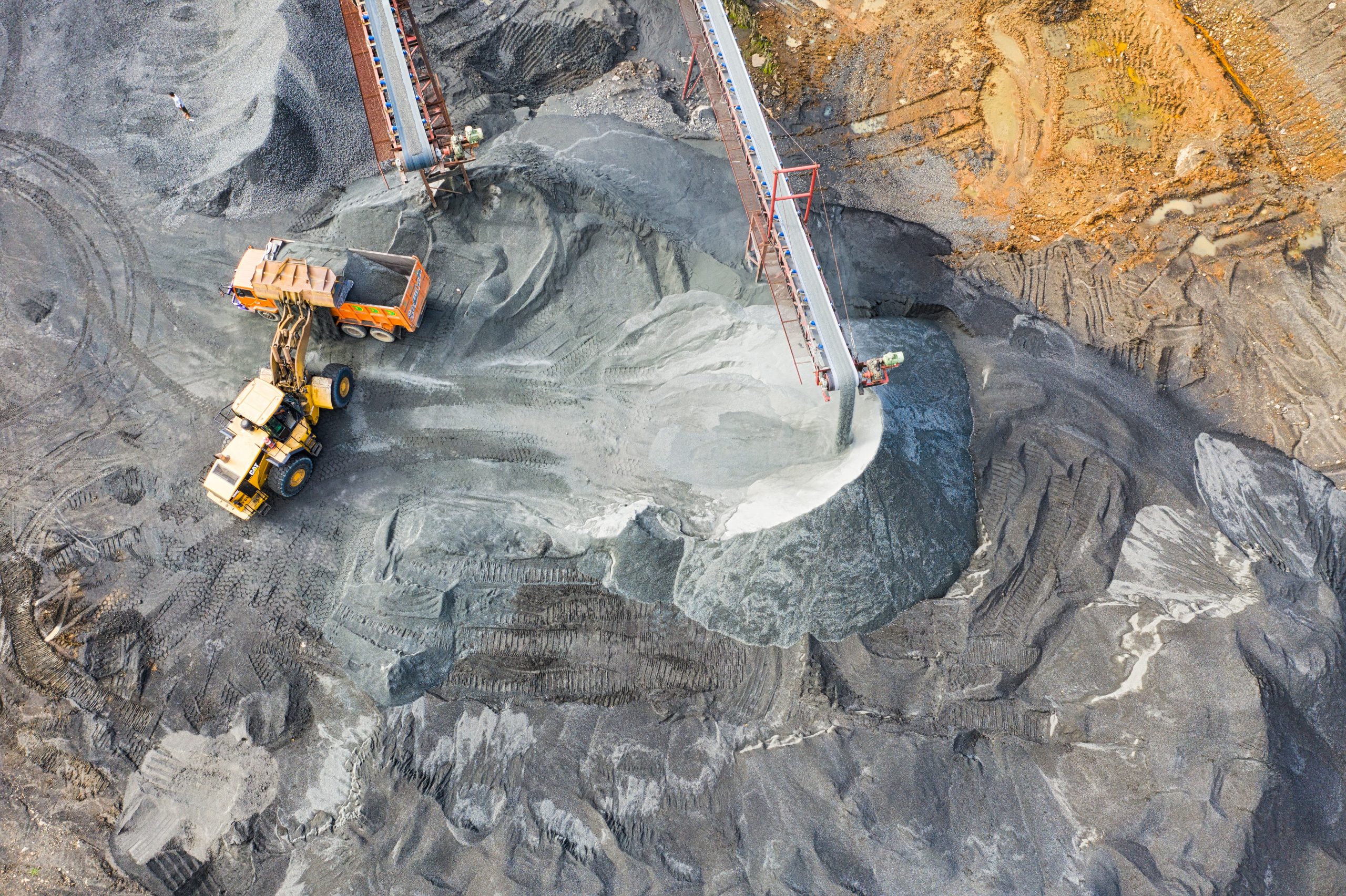
Mining is one of the most important and oldest industries in the world. It is responsible for extracting valuable resources from the earth that are used to create everything from consumer goods to infrastructure. As with any critical industry, mining has a responsibility to operate in a way that is socially and environmentally responsible. This is known as ESG governance, or corporate social responsibility (CSR) in mining.
ESG Principles
In general, good ESG governance in mining includes four key principles:
- Respecting the human rights of employees, contractors, and local communities
- Minimizing environmental impacts
- Operating in a transparent and accountable manner
- Building strong relationships with local communities
Mining companies focus on ESG in order to create long-term shareholder value and minimize reputational risks. In recent years, there has been an increased focus on ESG among institutional investors and rating agencies. This is because ESG factors can have a material impact on a company’s financial performance.
ESG governance is important for a number of reasons. First, it is the right thing to do. Mining companies have a responsibility to operate in a way that is socially and environmentally responsible. Second, good ESG governance can help mining companies create long-term shareholder value. Third, it can help minimize reputational risks. And finally, ESG factors can have a material impact on a company’s financial and operational performance. Companies that are governed with a responsible and sustainable focus will be better positioned to weather challenges and capitalize on opportunities in the future.
Honey Badger Silver’s Commitment to ESG
Honey Badger Silver (TSXV:TUF) is a Canadian mining company that is committed to good ESG governance. The company has implemented a number of policies and procedures to ensure that it operates in a socially and environmentally responsible manner.
The company has reported that it is actively engaged in pursuing an environmental, social, and governance core strategy to create sustainable, and future-oriented value for shareholders. Honey Badger is demonstrating a commitment to effective and equitable governance, through a board of directors and management that represent leading experts in capital markets, geological expertise, and mineral advancement.
Chad Williams, Director and Non-Executive Chair, believes that “ESG must be viewed as relevant at all stages of the mining cycle if we are to be able to safeguard the future of our natural resources and promote biodiversity. To ensure that our people, partnerships and communities thrive as our business grows, we must have a system in place that gauges the board’s effectiveness to fulfill its responsibilities to the Company’s shareholders, as well as to social and environmental best practices, including the fight against climate change and the global collaborative goal to achieve net zero carbon emissions by 2050.”
The above references an opinion and is for information purposes only. It is not intended to be investment advice. Seek a licensed professional for investment advice. The author is not an insider or shareholder of any of the companies mentioned above.

A new lithium processing plant is in the works according to Albemarle (NYSE:ALB), in a plan to create a plant that would end up producing as much lithium as the company produces today. Electric vehicles use lithium in their batteries, and with the rise in sales of these types of vehicles, it’s no wonder that Albemarle is taking this step. The move signals Albemarle’s strategy to be a key player in an all-electric economy.
The United States requires lithium to be imported in order to meet the demands of electric vehicle production. However, with this new processing plant, Albemarle would be able to provide all the lithium that is needed for these vehicles. This is a huge shift and one that could have a big impact on the economy and environment.
With this expansion, Albemarle aims to be part of the US supply chain in a major way, handling mine development, process, and manufacturing for the critical metal that is used to make EV batteries.
The advantages of having a local source of lithium are many. It would create jobs, reduce the country’s reliance on imports and be more environmentally friendly than current mining practices.
Albemarle is taking on this project because of the past few quarters seeing a rise in the number of announced EV manufacturing plants. These announcements and further construction of the plants could fuel a huge demand surge that the United States would struggle to keep up with at current production rates.
At the Fastmarkets Lithium Supply and Battery Raw Materials conference in Phoenix Arizona, Eric, Norris, head of Albemarle’s lithium division said, “There isn’t enough (lithium) supply yet to supply the ambitions of the US. This (processing plant) will be essential for our success in the future.”
The new processing plant would have 100,000 tonnes of annual capacity and might be located somewhere in the southeastern United States where there could be rail access to a major port. This will contribute to the company’s goal of boosting its lithium production capacity to 500,000 tonnes per year by 2030.
The company is already in talks with automakers to secure deals for the facility. Automakers and Albemarle are discussing buying supply from the facility. Currently, Albemarle supplies Tesla, among some other major automakers.
The US plant would be similar to one the company opened in Kemerton, Western Australia. However, the plant needs to cost less than the one in Kemerton since the costs ultimately grew past the initial goal of $1.2 billion. And while Albemarle is planning to fund the US plant itself, it could also apply for US Department of Energy loans for the project.
To supply the processing plant, the Kings Mountain mine in North Carolina could be reopened, possibly by 2027 to prepare for the opening of the new plant.
The above references an opinion and is for information purposes only. It is not intended to be investment advice. Seek a licensed professional for investment advice. The author is not an insider or shareholder of any of the companies mentioned above.
Canada Nickel Company (TSXV:CNC) has reported new assay results from its Reid property. The company has completed two drill holes as part of its regional exploration program. Hole REI21-02 intersected 354 metres of 0.24% nickel and includes 15 of 0.39% nickel and 6 metres of 0.57% nickel. These holes hold the same heazlewoodite-pentlandite-awaruite minerals as the Crawford property according to the mineralogy completed on those samples.
Mark Selby, Chair and Chief Executive Officer of Canada Nickel Company commented in a press release: “We are very pleased with our drilling on the Reid target. The assay results from the second hole achieved expected grades over 354 metres and contains a core of higher grade mineralization of 15 metres of 0.39% nickel, and the first hole intersected a PGM zone similar to that at Crawford. We are continuing to drill Reid as we highlight the resource potential of this target with a larger geophysical footprint than our original Crawford discovery. Additionally, we are looking forward to the release of our updated resource estimate for Crawford expected to be released by July 6, 2022.”
Highlights from the drilling are as follows:
- Assays achieved expected grades over entire core length of 354 metres: 0.24% nickel including 15 metres of 0.39% nickel and 6 metres of 0.57% nickel
- Confirmed same mineralogy as Company’s flagship Crawford Project
- Reid property has larger geophysical footprint than Crawford
- Crawford resource update expected to be released by July 6, 2022
Reid Nickel Property
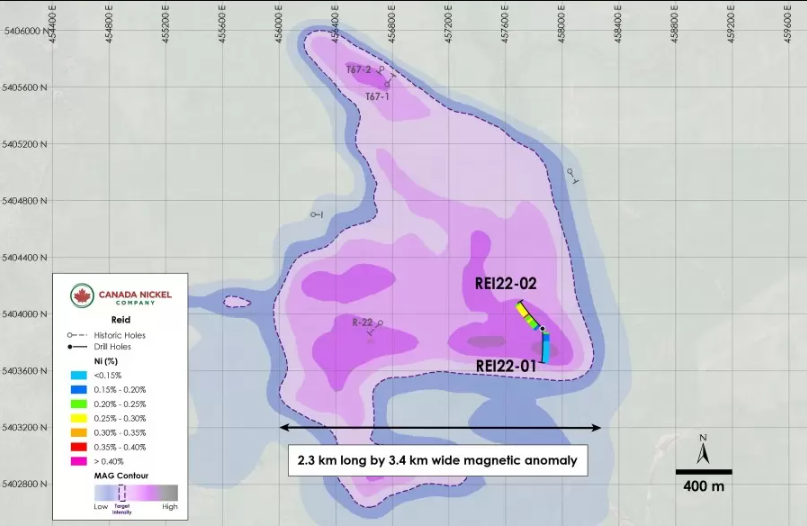
The Reid Property is located just 16 kilometres southwest of Crawford and contains an ultramafic target that measures 3.3 kilometres north-south by 2.1 kilometres east-west based on the total magnetic intensity (“TMI”) (see Figure 1). Hole REI-22-02 collared on dunite in the SE corner of the target, and was drilled to the NW. It remained in dunite for a total length of 354 metres grading 0.24% nickel, with a higher-grade section near the bottom of the hole intersecting 0.39% nickel over 15 metres (see table 1A). The hole ended in mineralized dunite, and the contact is open to the north.
REI22-01 collared on dunite in the same setup, drilling towards the south contact where the magnetic anomaly is at its highest. The hole transitioned from dunite to a sequence of peridotite-pyroxenite-gabbro similar to that seen at Crawford. The pyroxenite in the sequence yielded 1.6g/t Pt+Pd over 4.5 metres (see Table 1B) similar in grade and thickness to PGM zone at Crawford.
Mineralogy completed on samples from these holes confirmed that they contain the same heazlewoodite-pentlandite-awaruite minerals as Crawford.
As of June, drilling at Reid resumed with a helicopter supported program that will test the extent of the anomaly.
Table 1A: Reid Exploration Drilling Results, Ontario.
|
Hole ID |
From |
To |
Length |
Ni |
Co |
Pd |
Pt |
Cr |
Fe |
S |
|
(m) |
(m) |
(m) |
( %) |
( %) |
(g/t) |
(g/t) |
( %) |
( %) |
( %) |
|
|
REI22-01 |
51.0 |
153.4 |
102.4 |
0.17 |
0.01 |
0.00 |
0.01 |
0.44 |
7.29 |
0.02 |
|
REI22-02 |
42.0 |
396.0 |
354.0 |
0.24 |
0.01 |
0.00 |
0.01 |
0.53 |
5.97 |
0.02 |
|
including |
227.5 |
394.0 |
166.5 |
0.27 |
0.01 |
0.01 |
0.01 |
0.61 |
5.66 |
0.03 |
|
including |
227.5 |
242.5 |
15.0 |
0.39 |
0.01 |
0.05 |
0.03 |
0.43 |
6.28 |
0.07 |
|
including |
236.5 |
242.5 |
6.0 |
0.57 |
0.02 |
0.05 |
0.03 |
0.52 |
6.41 |
0.12 |
Table 1B: Reid Exploration Drilling Results, Ontario – PGMs
|
Hole ID |
From |
To |
Length |
PGM |
Pd |
Pt |
Ni |
Co |
Cr |
Fe |
S |
|
(m) |
(m) |
(m) |
(g/t) |
(g/t) |
(g/t) |
( %) |
( %) |
( %) |
( %) |
( %) |
|
|
REI22-01 |
264.5 |
270.5 |
6.0 |
1.35 |
0.75 |
0.61 |
0.03 |
0.01 |
0.29 |
5.89 |
0.01 |
|
including |
266.0 |
270.5 |
4.5 |
1.67 |
0.93 |
0.75 |
0.02 |
0.01 |
0.29 |
5.55 |
0.01 |
|
including |
267.5 |
269.0 |
1.5 |
2.02 |
1.15 |
0.87 |
0.02 |
0.01 |
0.26 |
5.36 |
0.01 |
Table 2: Drill Hole Orientation.
|
Hole ID |
Easting |
Northing |
Azimuth |
Dip |
Length |
|
(mE) |
(mN) |
(⁰) |
(⁰) |
(m) |
|
|
REI22-01 |
457,859 |
5,403,898 |
175 |
-50 |
329.0 |
|
REI22-02 |
457,859 |
5,403,898 |
316 |
-50 |
354.0 |
Source: Canada Nickel Company
The above references an opinion and is for information purposes only. It is not intended to be investment advice. Seek a licensed professional for investment advice. The author is not an insider or shareholder of any of the companies mentioned above.

Brazil Potash, a Canada-based potash mining company, has put forward a bold vision for a bold new potash project in Brazil that aims to both challenge the oligopoly entrenched in the industry and create a better future for Brazil. That project is the Autazes Project.
Potash Mining
Currently, there are two main ways potash is mined – conventional and solution. Conventional mining entails the sinking of shafts to reach the underground potash and the use of boring machines to extract it for transport to the surface where it is concentrated into a saleable product. With solution mining, hot water is piped down to the underground potash to dissolve it for transportation back to surface for processing.
The state of the potash market is currently controlled by a small group of companies, known as an oligopoly. This control gives these companies a large amount of power over price and availability. Brazil is one country that is highly dependent on imported potash – the country imports 96% of the potash it needs out of which 47% comes from Russia and Belarus which are both sanctioned. This leaves Brazilian agriculture at the mercy of these foreign suppliers.
Brazil Potash will aim to challenge that market by introducing a new project with multiple competitive advantages. The first is the sheer size of the Amazon potash basin that Brazil Potash’s Autazes project will source its potash from. The Amazon potash basin is estimated to be one of the largest proven potash fertilizer projects in the world, comparable to the massive potash basins in Canada and Russia where ~80% of the world’s potash is sourced.
The project also has a major logistical advantage because it will be located on existing farmland near the Amazon river system. Thanks to the favourable infrastructure, ideal location, and a successful feasibility study and environmental and social impact assessment already complete, the Autazes project will be the lowest-cost source of potash for Brazil – a major shift for the industry and the country.
Currently, the company sees a life of mine of 23 years based on exploring only ~7% of the Amazon potash basins potential, with an estimated annual EBITDA of US$ 1.1 billion. Once the mine is producing, this could give the Brazil Potash an approximate market cap between US$ 7 billion and US$ 10 billion based on just its initial planned production of 2.4 million tonnes per year to supply ~20% of Brazil’s current needs.
Autazes
The Autazes project is designed to be more than a game-changing potash mine. The company sees the project as an impact project with benefits across multiple social and economic factors. The project will create around 5000 direct and indirect jobs over several decades of operation that will have a positive impact on the local and regional economy.
Brazil Potash has a strong ESG policy in place, with plans for investing in local school programs, ensuring that no primary rainforest is affected by the project (small footprint) and that the potash supply will go on to facilitate the reuse of the existing arable land to help mitigate deforestation further. The company has estimated that the project will reduce greenhouse gases by more than 1.3 million tonnes per year.
Potash mining is a capital-intensive process, but with a strong project and a favourable market, Brazil Potash is well-positioned to take on the challenge and become a new player in the potash industry.
Roadmap Underway
Brazil Potash has brought its Autazes project to a near construction-ready state having completed a bankable feasibility study, environmental and social impact assessment, and public hearings with over 4000 people including currently ongoing indigenous consultations.
The next stage will see the company raise the US$ 2.1 billion needed for the construction of the Autazes Project to bring it into operation to supply this essential nutrient to feed not only the people of Brazil but people globally.
The above references an opinion and is for information purposes only. It is not intended to be investment advice. Seek a licensed professional for investment advice. The author is not an insider or shareholder of any of the companies mentioned above.
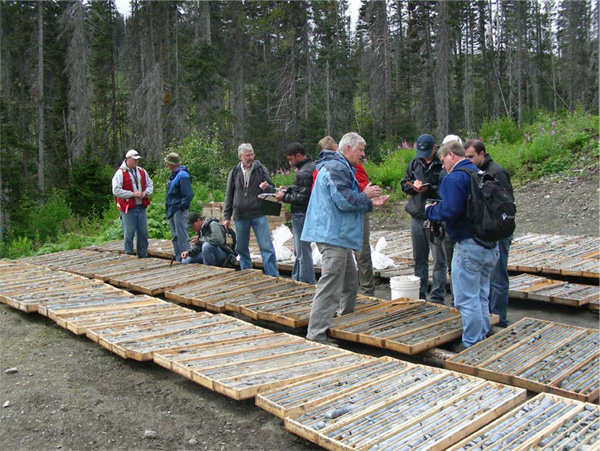
FPX Nickel (TSXV:FPX) has announced that a signed memorandum of agreement with indigenous partner Binche Keyoh Bu Society will now formalize protocols around the development of the Decar Nickel District in central British Columbia, Canada. The MoA follows a previously signed MoU with the Tl’azt’en Nation, including the Binche Keyoh families that are represented by the Binche Society. The Binche Society is a not-for-profit community organization that represents the Keyoh families with the Binche Whut’en consultative boundary in central B.C. Binche was then de-amalgamated from the Tl’azt’en Nation, and in 2019, formed the Binche Whut’en.
The MoA
The MoA formalizes protocols surrounding the development of the Dear nickel property, and signals a cooperative working relationship in regards to exploration and development activities at the property. The MoS also outlines other ways to manage the project activities when it comes to the cultural and environmental interests of the Binche Whut’enne, the socio-economic benefits, and community consultation activities and processes with the Binche community.
FPX Nickel president and CEO martin Turenne commented: “Since the beginning of exploration activities at Decar in 2008, FPX has worked respectfully with the traditional Keyoh families of Binche Whut’enne and Tl’azt’enne to create shared value through employment and economic opportunities while also being responsible stewards of the natural environment. The signing of this Memorandum of Agreement marks an important milestone in the continued development of a mutually beneficial partnership between FPX and the Keyoh families of Binche Whut’enne.”
The Decar project is a greenfield discovery of nickel mineralization. This means that the project is still in its early stages of development, and has not yet reached full commercial production. The mineralization is in the form of a naturally occurring nickel-iron alloy called awaruite. The property is 245km² 90 km northwest of Fort St. in part of the mount Signey Williams ultramafic/ophiolite complex.
With the new MoA in place, FPX Nickel now has the support of the Binche Society. The company can now begin the necessary offsite engineering and scientific studies to move forward with the project followed by an on-site field programme.
The above references an opinion and is for information purposes only. It is not intended to be investment advice. Seek a licensed professional for investment advice. The author is not an insider or shareholder of any of the companies mentioned above.
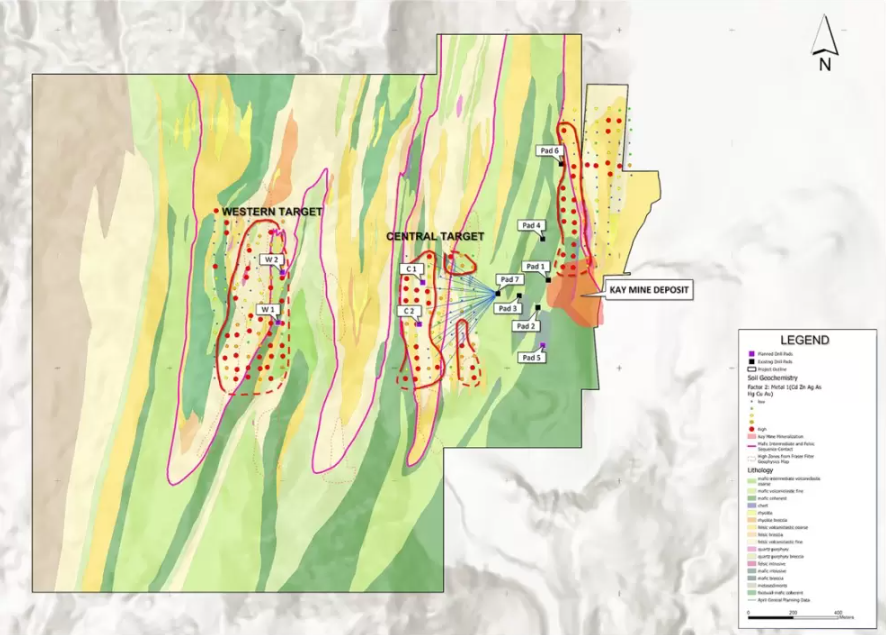
Arizona Metals Corp. (TSXV:AMC) has announced that it has received permit approval from the Bureau of Land Management for two new drill pads to be installed. The pads will be located roughly 500 metres west of the Kay Mine deposit. The pads are meant to allow for the testing of the Central Target in the west, and the drilling of additional coincident anomalies located between the Central and Western Targets. Both targets had been previously defined based on coincident structural, geochemical, and geophysical anomalies.
The initial drill program of 11,000 metres with up to 20 holes is planned at the Central Target, beginning with pad 7. The third hole from pad 7 is also underway now. A bond for pads C1 and C2 will be posted this week with the construction of the pads and drill road contingent on confirmation of bond acceptance. The company estimates acceptance to be confirmed in August 2022. In June 2022, the company expects to submit another permit modification for drilling at the Western Target. The company has 26 holes pending results from ongoing drilling at the Kay Mine deposit.
CEO of Arizona Metals, Marc Pais, commented in a press release: “We are very pleased to announce the receipt of a permit for 2 new drill pads, C1 and C2, located approximately 500 m west of the Kay Mine Deposit. These pads will allow testing of Central target from its western side, and also testing of the areas between the Central and Western Targets. Pad 7 was successfully permitted and constructed, and drilling to test the Central target from the east is currently underway. Drill holes from pads 7, C1, and C2 will all target areas previously untested by drilling, but that have many of the same characteristics we see at the Kay Mine deposit.
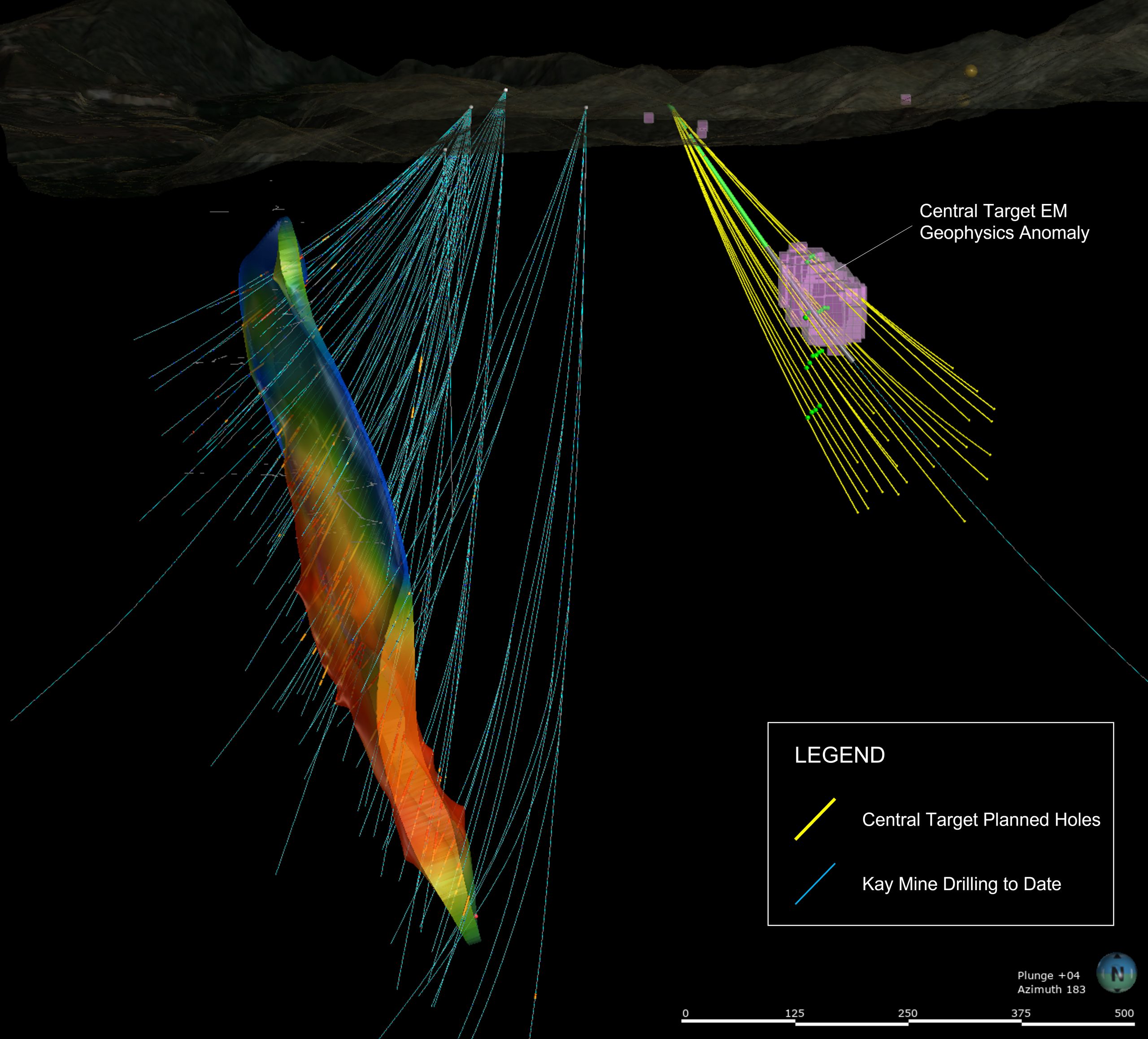
This drilling is part of the larger, fully-funded Phase 3 program, which will total at least 76,000 m and cover the western extent of the Kay Mine Project. Two drill rigs continue to turn at the Kay Deposit, with concurrent goals of discovery and resource definition. The Company is fully-funded to continue drilling at Kay, while also undertaking the first detailed exploration of the Central and Western Targets in the known history of the property.”
Arizona Metals Corp. has completed 61,000 metres of drilling a the Kay Mine since the start of the drill program, and is fully-funded to complete the remaining 14,000 metres planned for Phase 1. Funding is also secured for the 76,000 metres that will be part of the Phase 3 program. Phase 3 will be used to test multiple parallel targets heading West of Kay and Northern and Southern Extensions of the Kay Deposit.
The above references an opinion and is for information purposes only. It is not intended to be investment advice. Seek a licensed professional for investment advice. The author is not an insider or shareholder of any of the companies mentioned above.
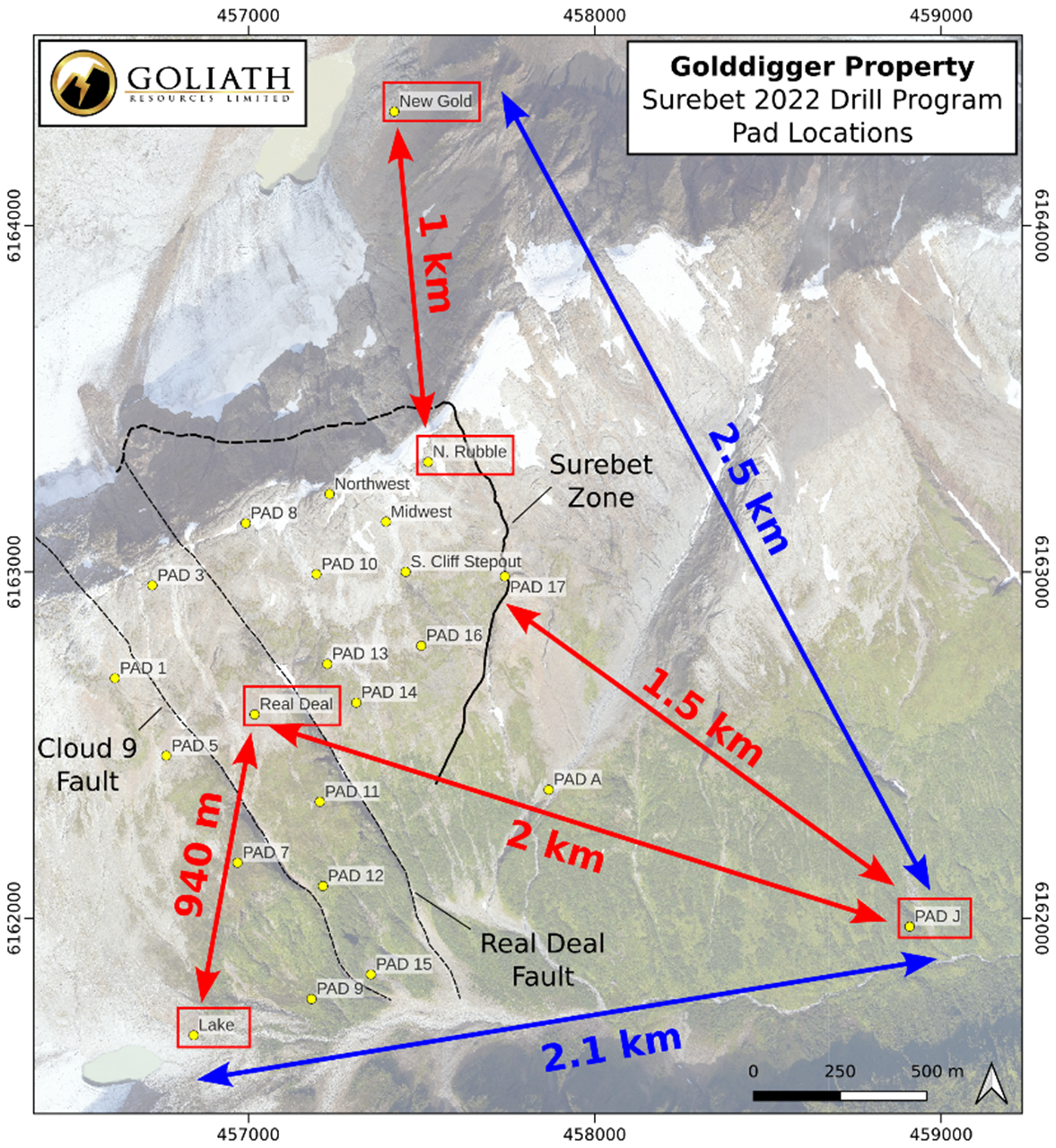
Goliath Resources (TSXV:GOT) has announced new initial observations from the first successful inaugural hole out of 84 planned drill holes at the Golddigger Property. Located in Golden Triangle, B.C., the 100%-owned property has begun its 2022 diamond drill campaign at the Surebet discovery on the property.
Founder and CEO of Goliath Resources Roger Rosmus commented in a press release: “We are off to an exciting 2022 drill season. Initial results from the inaugural hole with multiple broad intercepts of mineralization have far exceeded our expectations. Mineralization confirmed in the inaugural hole at the New Extension Target strongly indicates the presence of a large mineralizing system at depth on the Golddigger property. The planned 24,000 m drill program will test areas to the east, north and west of the known mineralization covering 5.25 square km and allow us to better understand the relationship between Surebet, the New Extension Target and New Gold. Surebet is shaping up to become the next big high-grade gold-silver discovery in the Golden Triangle, B.C.”
Highlights from the drilling are as follows:
- The first hole of 2022 (GD-22-25) on Pad J in the New Extension Target has intersected five broad intervals of disseminated and vein/breccia hosted sulphide mineralization near surface up to 95.5 m containing pyrrhotite, pyrite and chalcopyrite in Hazelton volcanics. Assays are pending and will be released once received, compiled, and interpreted.
- An accompanying infographic is available at: Click Here
- An accompanying infographic is available at: Click Here
- An accompanying infographic is available at: Click Here
- The extensive mineralizing system has been confirmed over 1 km North-South along the Surebet Zone and 2 km East-West from Real Deal to the newly drilled Pad J located in the New Extension Target (see map below); it remains open in all directions.
- An accompanying infographic is available at: Click Here
- The 2022 drill program is designed to expand the extent of known mineralization from 2021 in all directions, including to the West (to Lake Pad, 940 m SW of Real Deal), test the known gold mineralization to the North (to New Gold, 1 km north of North Rubble), and to the East (to Pad J within the New Extension Target, 1.5 Km South-East of the Surebet Outcrop where initial drilling has confirmed multiple broad zones of mineralization)
- The 2022 drill program will focus on expanding the known parameters of the Surebet high-grade gold-silver discovery with 24,000 m of drilling planned in 84 holes from 24 pad locations using 4 drill rigs. Its designed for resource level infill drilling and outline the large mineralized system over an area of 2.1 km East-West by 2.5 km North-South (5.25 square kilometers).
GD-22-25 (E 458908.947, N 6161976.043, azimuth 120°; dip -85°) was collared from Pad J the most easterly pad planned for 2022 at the New Extension Target located 1.5 km South-East of the outcropping Surebet and 2 km East-West from Real Deal.
Inaugural drilling on the New Extension Target intercepted five broad mineralized intervals characterized by disseminated sulphides, sulphides in stringers, veins and breccias containing pyrrhotite, pyrite and chalcopyrite. The Intervals are from bedrock at 42.4 m to 137.9 m, 181.9 m to 190.37 m, 202.08 m to 222.14 m, 256.9 m to 261.08 m, and 276.01 m to 353.00 m (end of hole) and remains open. The target of this hole was surface mineralization consisting of multiple channel and grab samples containing up to 44.4 gpt Au and 1629 gpt Ag modelled to be intersected at 200-250 m down hole.
Sulphide mineralization primarily occurs disseminated throughout an epidotized andesitic volcanic host rock and as millimeter to centimeter-size stringers and aggregations within quartz and quartz-epidote veins and breccia. The majority consist of pyrrhotite (locally up to 2 %), pyrite (locally up to 5 %) and chalcopyrite (locally up to 3%). A fault zone was intersected from 69.63 m to 78.09 m which is believed to have partially displaced the mineralized units. The drilling and data continue to confirm the presence of a large mineralizing system on the property and mineralization remains open in all directions.
During the 2022 drill campaign, Goliath plans to test the Surebet mineralized system at depth over an extensive area reaching as far as Lake Pad to the West (940 m SW of Real Deal) and New Gold to the North (1 km north of North Rubble) focused on delineating a mineralized area of 2.1 km East-West by 2.5 km North-South (see map above). Several drill locations are planned up to 600 meters West of Real Deal to target the Surebet mineralized system at depth based on the projected model generated from the 2021 drill results and 2020 channel sample results.
A series of drill holes are planned for the New Gold zone located 1 km north of Surebet. Similarly to the New Extension Target, this zone contains surface gold mineralization over 400 meters that remains open with ~ 30 m of gold bearing breccia also observed in outcrop. The New Gold Zone is hosted in Hazelton volcanics in close proximity to the ‘Red Line’. The majority of the world class mineral deposits discovered within the Golden Triangle are hosted in the Hazelton volcanics and occur within a few kilometers of the unconformity between Lower Hazelton and Stuhini rocks (also known as the ‘Red Line’).
Multiple surface channel, chip and grab samples collected from Real Deal and Cloud 9 secondary structures believed to be associated with the Surebet Zone within this area returned significant gold and silver values, further confirming the presence of a large gold-silver rich mineralizing system at depth. These secondary structures are interpreted to be acting as conduits for fluids to the surface.
Source: Goliath Resources
The above references an opinion and is for information purposes only. It is not intended to be investment advice. Seek a licensed professional for investment advice. The author is not an insider or shareholder of any of the companies mentioned above.
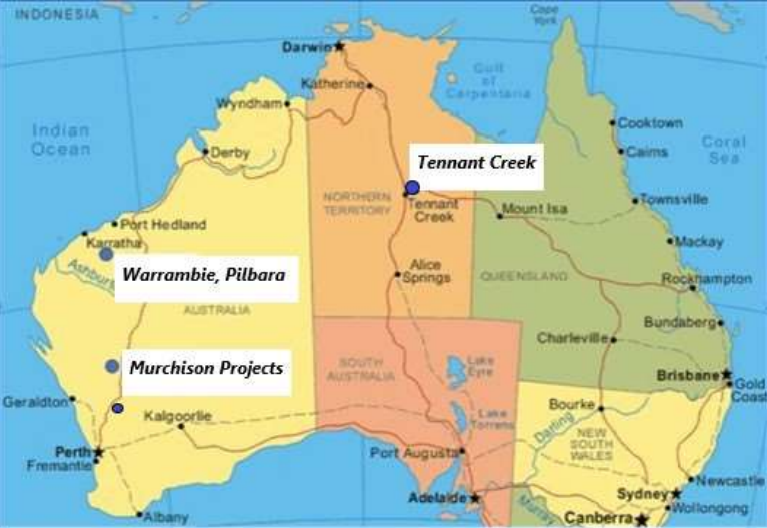
Metals Australia announced that it has signed an agreement to acquire 80% of Payne Gully Gold (PGG) an Australian mining company with highly prospective battery and precious metals projects in Australia. Metals Australia will issue 40 million shares at $0.07, plus 84 million shares at $0.07 plus a $300,000 cash payment to PGG vendors, with the agreement and subsequent deal subject to shareholder approval. The deal is expected to enhance Metals Australia’s portfolio of gold and battery metals projects in Western Australia and the Northern Territory.
Mike Scivolo, Metals Australia chairman, commented in a press release: “The company has taken advantage of an outstanding opportunity to acquire a suite of highly prospective battery metals and gold projects with multiple drill targets near major deposits in tier one jurisdictions. These new projects give Metals Australia the opportunity to build on its exploration success over the past few months. The Payne Gully acquisition is in line with the company’s focus on projects in highly-prospective mineralised terranes such as in the Yilgarn and Pilbara regions of Western Australia, and the Tennant Creek region of the Northern Territory.”
The company’s main projects include the Murchison Domain gold project in Western Australia, the Warrambie nickel-copper-cobalt project, and the Tennant Creek copper-gold project in the Northern Territory.
Tennant Creek
The three tenements that make up the Tennant Creek project are located near the Warrego high-grade copper-gold deposit and one other near Tennant Minerals’ Bluebird copper-gold discovery.
Warrambie
The Warrambie project is considered highly prospective due to mafic intrusive nickel-copper-cobalt sulphide mineralisation. It is located in the Pilbara region, and it is sandwiched between Sabre Resources’ Sherlock Bay nickel sulphide project and the Andover nickel sulphide discovery.
Murchison
The Murchison Domain project has four tenements which are highly prospective due to major gold deposits and gold and Ni-Cu-Co-PGE mineralisation. The four prospects are all prospective for the company.
The above references an opinion and is for information purposes only. It is not intended to be investment advice. Seek a licensed professional for investment advice. The author is not an insider or shareholder of any of the companies mentioned above.
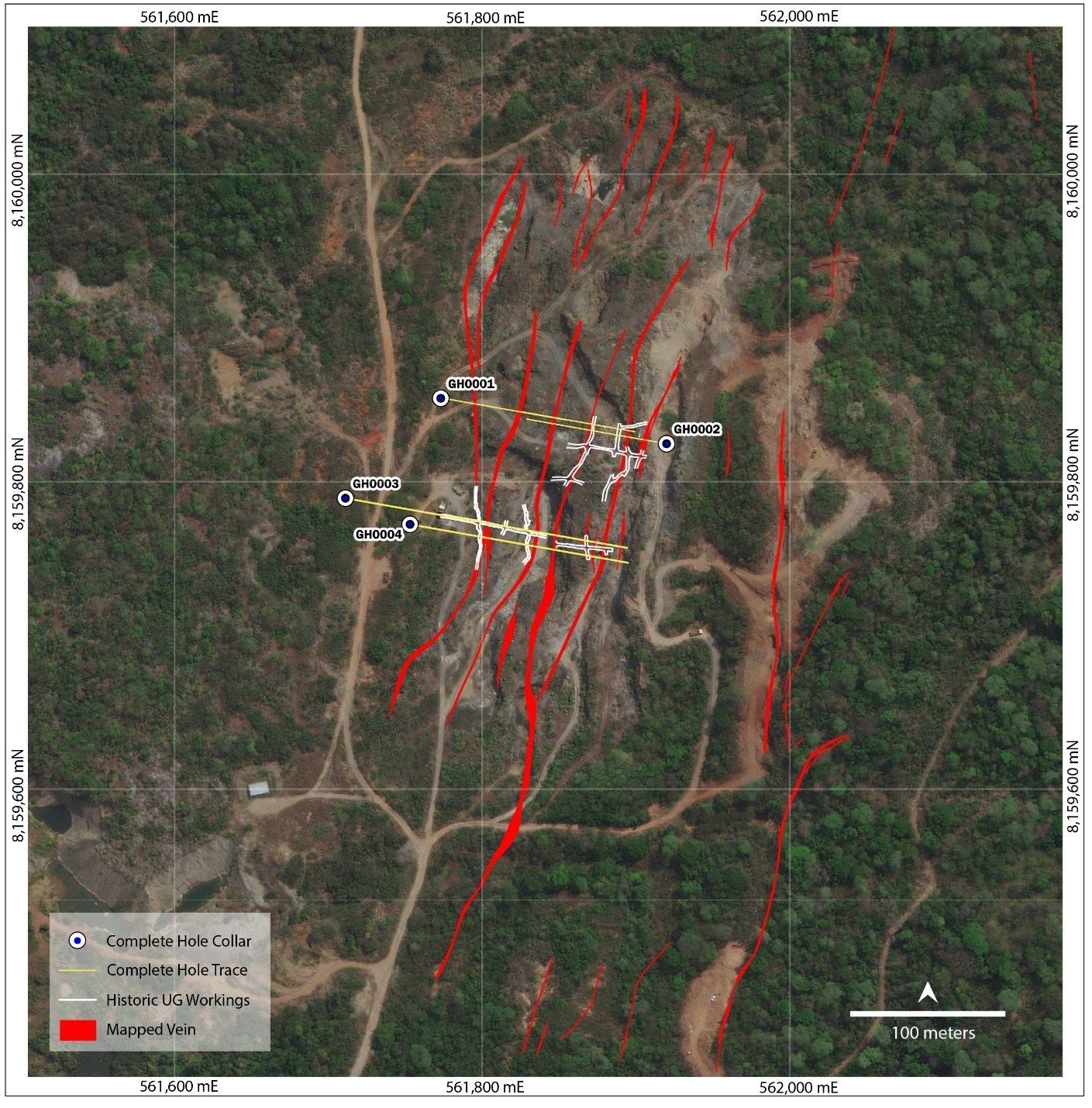
Mantaro Precious Metals (TSXV:MNTR) has announced results from the down dip extension of five historically mined veins at its La Escarcha project, and that it has completed the first four drill holes at its Golden Hill Property.
As part of the maiden 5,000-metre drill program at the La Escarcha deposits, Mantaro has drilled 720 metres. The news of the completion of the first four diamond drill holes also came with the confirmation of down dip extensions, intercepted from the five primary gold-bearing quartz shear zones exploited via surface open and underground workings at the mine. This work was historically completed to depths of 150 metres beneath surface.
Craig Hairfield, Chief Executive Officer of Mantaro Precious Metals, commented in a press release: “We are extremely pleased with the progress made by our team and Leduc Drilling at La Escarcha. Core recovery has been excellent. The four holes drilled to date have all intercepted sulphidic quartz-carbonate veins and veinlets beneath mineralization mapped in underground workings. Mineralization is open in all directions and the next phase of drilling will initially target the southern and northern strike extensions of the system. The system remains open at depth. It is anticipated that the first batch of samples will be dispatched to ALS this week and assays are expected approximately 6 weeks after.”
Highlights from the results are as follows:
- Four diamond drill holes completed for a total of 720 meters, confirming down dip extensions of the La Escarcha gold deposit (See Figure 1).
- Initial drilling has successfully intercepted down dip extensions of the five primary gold bearing quartz shear zones historically exploited via surface open pit and underground workings at La Escarcha Mine, to depths of 150 meters beneath surface.
The initial holes are targeting down dip extensions of historically mined veins at La Escarcha open pit, aiming to confirm high-grade gold mineralization beneath the extent of historic mining (ie. below 60 meter depth). Drilling has successfully intercepted broad multiphase quartz shear zones typical of greenstone hosted orogenic gold deposits. The program has also confirmed down dip extensions of the historically mined C1, C2, C3, C and C4 gold bearing quartz shear zones at La Escarcha gold deposit, to depths of 150 meters beneath surface.
The vast majority of the diamond drilling was drilled in PQ diameter and reduced to NQ size at 150 meters depth in hole GH0003. Holes have been drilled from -34 ° to -61 ° dip, with hole lengths ranging from 170 to 250 meters, and an excellent core recovery of nearly 100%.
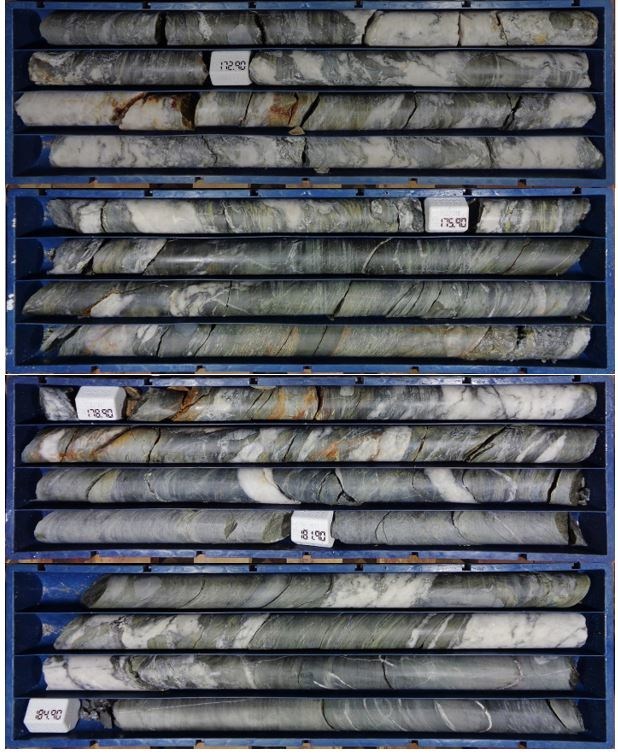
Additional drilling aims to further extend the down dip and strike extensions of the five key gold bearing structures at La Escarcha gold deposit. Thereafter, the drill programs focus will shift to the southern strike extensions of the Golden Hill vein system, beneath areas with historic surface workings, at the Gabby and Garrapatillia prospects. Drilling will then be utilized to test gold mineralization across the parallel vein swarm located directly west of La Escarcha at the Westfield prospect.
Source: Mantaro Precious Metals
The above references an opinion and is for information purposes only. It is not intended to be investment advice. Seek a licensed professional for investment advice. The author is not an insider or shareholder of any of the companies mentioned above.

Trillium Gold Mines (TSXV:TGM) has signed an option agreement to acquire a 100% interest in Bounty Gold Corp.’s Wenasaga Gold Property. The acquisition extends Trillium Gold’s dominant land position along the Confederation belt and is on trend with Kinross Gold’s LP Fault Zone of the Dixie Deposit. The Wenasaga Gold Property spans 1,692 hectares and is located 30 kilometres northeast of Ear Falls and 55 kilometres southeast of Red Lake, a prolific mining district.
Historical drilling at the property to the west and on strike along the crystal fault structure intercepted highly deformed, chloritic and carbonate altered green basic metavolcanic rocks. It contains similar regional geology to the Dixie Project; it is underlain with felsic intrusive and metasedimentary rocks in the north. Trillium Gold’s exploration program at the property will be focused on delineating the fault structure transecting the Wenasaga Gold Property.
The Option Agreement
Pursuant to the terms of the Agreement, in order to keep the option thereunder in good standing, Trillium is required to pay Bounty Gold an aggregate amount of Cdn $25,500 over a period of two years, issue an aggregate 64,500 common shares in the capital of Trillium over a period of two years, and grant to Bounty Gold a 2.0% Net Smelter Returns royalty on the claims comprising the Property upon exercise of the option. The Company has the right to repurchase 50% of the royalty (being 1.0%) by paying the holder an aggregate amount equal to $1,000,000. The Common Shares of Trillium Gold issued under the Agreement will be subject to a four-month holding period from the closing date. The Agreement is subject to the approval of the TSXV and other applicable regulatory authorities, as well as the approval of the Ontario Mining Recorder to extend the due dates for assessment work.
Source: Trillium Gold
The above references an opinion and is for information purposes only. It is not intended to be investment advice. Seek a licensed professional for investment advice. The author is not an insider or shareholder of any of the companies mentioned above.
Orezone Gold (TSX:ORE) has announced ongoing drill results from its Phase 3 program at the Bomboré Gold Project in Burkina Faso. Results from P17S-NE along the P17 mineralized trend have been reported from the program. The Phase 3 drilling at P17S was focused to define the continuity of the repeat, folded, high-grade granodiorite mineralized zones. The positive results announced by the company confirmed those zones.
Dr. Pascal Marquis, SVP of Exploration, commented in a press release: “I am extremely pleased with the ongoing drilling results at P17S, which confirm that this deposit continues to grow, not only along the known zones, but with new zones intersected outside of the current resource pit shell. Final results from this program at P17S are expected in the coming weeks. Drilling is now underway at the Siga deposits, as part of our resource conversion program, but we expect to be back drilling at P17S later this year to follow up on these very encouraging results.”
Highlights from the drill results are as follows:
- Down-plunge continuity of the mineralized zones at P17S has now been extended over an additional 100 m beyond the last set of drill results, with more results pending over the next 100 m.
- Drilling has also intercepted significant new mineralization in the footwall of the resource area with Hole BBD1132 returning 30 m of 1.73 g/t Au, which is still open both up and down plunge.
- The mineralized zones are open towards the surface and at depth over a strike of at least 300 m.
P17S Drilling Highlights:
- 20.30 m of 1.88 g/t Au from 171.00 m in hole BBD1104
- 10.65 m of 3.69 g/t Au from 190.00 m in hole BBD1108
- 45.30 m of 1.29 g/t Au from 189.00 m in hole BBD1110
- 18.00 m of 1.59 g/t Au from 134.00 m and 22.15 m of
1.34 g/t Au from 179.85 m in hole BBD1118
- 12.00 m of 2.45 g/t Au from 76.00 m in hole BBD1119
- 18.00 m of 1.74 g/t Au from 124.00 m in hole BBD1120
- 19.50 m of 3.20 g/t Au from 230.50 m in hole BBD1131
- 8.00 m of 6.32 g/t Au from 127.00 m and 30.00 m of
1.73 g/t Au from 245.00 m in hole BBD1132
Table 1: P17 Trend Highlight Drill Results
| Hole # |
From (m) |
To (m) |
Length (m)* |
Grade (g/t gold) |
|||||
| BBD1104 | 134.00 | 143.00 | 9.00 | 2.69 | |||||
| and | 171.00 | 191.30 | 20.30 | 1.88 | |||||
| incl. | 171.00 | 178.00 | 7.00 | 2.13 | |||||
| BBD1105 | 141.00 | 146.00 | 5.00 | 2.58 | |||||
| and | 166.00 | 178.00 | 12.00 | 1.98 | |||||
| and | 200.00 | 209.00 | 9.00 | 2.27 | |||||
| and | 222.00 | 226.90 | 4.90 | 2.16 | |||||
| and | 245.40 | 251.40 | 6.00 | 2.85 | |||||
| BBD1106 | 167.00 | 184.00 | 17.00 | 1.14 | |||||
| and | 190.00 | 205.15 | 15.15 | 1.75 | |||||
| incl. | 192.00 | 193.00 | 1.00 | 10.84 | |||||
| BBD1107 | 67.00 | 84.00 | 17.00 | 1.47 | |||||
| BBD1108 | 106.70 | 109.00 | 2.30 | 4.66 | |||||
| incl. | 106.70 | 107.80 | 1.10 | 9.04 | |||||
| and | 118.00 | 135.00 | 17.00 | 1.44 | |||||
| and | 190.00 | 200.65 | 10.65 | 3.69 | |||||
| incl. | 193.00 | 198.20 | 5.20 | 6.40 | |||||
| BBD1109** | 198.00 | 203.00 | 5.00 | 3.63** | |||||
| incl. | 201.00 | 203.00 | 2.00 | 6.88** | |||||
| and | 208.00 | 215.00 | 7.00 | 2.67** | |||||
| BBD1110** | 189.00 | 234.30 | 45.30 | 1.29** | |||||
| Incl. | 193.00 | 207.00 | 14.00 | 2.05** | |||||
| Incl. | 232.00 | 234.30 | 2.30 | 7.83** | |||||
| BBD1116 | 17.00 | 24.50 | 7.50 | 1.61 | |||||
| and | 48.00 | 53.00 | 5.00 | 2.79 | |||||
| and | 58.00 | 65.80 | 7.80 | 3.27 | |||||
| BBD1118 | 101.00 | 111.00 | 10.00 | 2.28 | |||||
| and | 134.00 | 152.00 | 18.00 | 1.59 | |||||
| and | 179.85 | 202.00 | 22.15 | 1.34 | |||||
| BBD1119 | 29.00 | 32.00 | 3.00 | 3.44 | |||||
| and | 76.00 | 88.00 | 12.00 | 2.45 | |||||
| incl. | 82.00 | 83.00 | 1.00 | 9.66 | |||||
| BBD1120 | 124.00 | 142.00 | 18.00 | 1.74 | |||||
| incl. | 126.00 | 127.00 | 1.00 | 11.45 | |||||
| BBD1122 | 195.00 | 211.00 | 16.00 | 1.43** | |||||
| and | 224.00 | 242.00 | 18.00 | 0.89** | |||||
| and | 280.35 | 287.20 | 6.85 | 2.86** | |||||
| BBD1123 | 199.00 | 201.00 | 2.00 | 5.63** | |||||
| Incl. | 199.00 | 200.00 | 1.00 | 9.27** | |||||
| BBD1131 | 230.50 | 250.00 | 19.50 | 3.20** | |||||
| incl. | 233.20 | 239.90 | 6.70 | 6.40** | |||||
| BBD1132 | 127.00 | 135.00 | 8.00 | 6.32** | |||||
| incl. | 127.00 | 133.00 | 6.00 | 7.89** | |||||
| and | 245.00 | 275.00 | 30.00 | 1.73** | |||||
* True widths for P17S drilling are approximately 90% of drilled lengths.
** Preliminary results without leach residue assays. Final grades will typically increase by 4-6% from those stated.
Figure 1: P17 Trend Plan Map
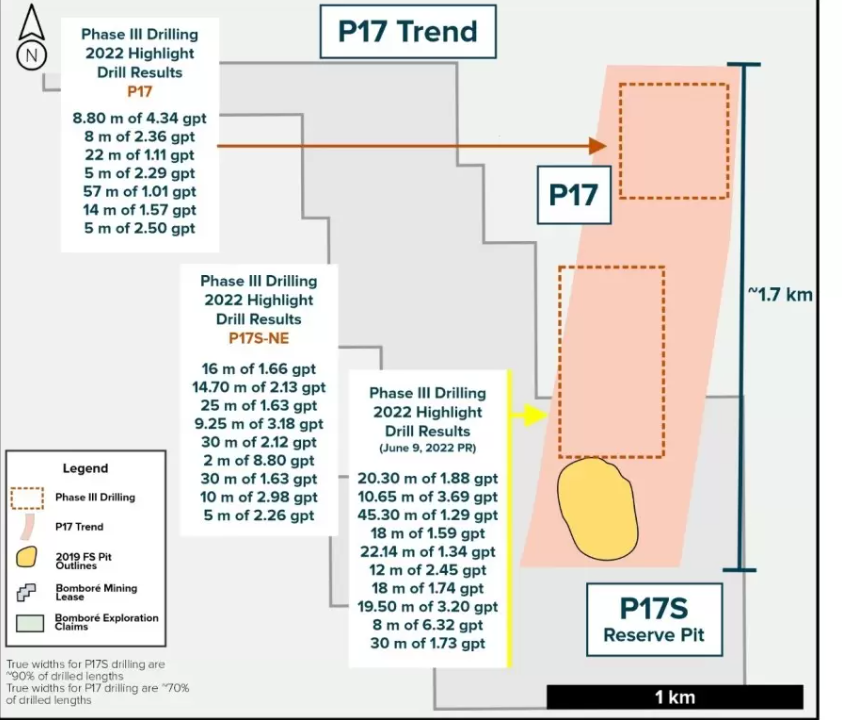
Figure 2: P17 Trend Long Section
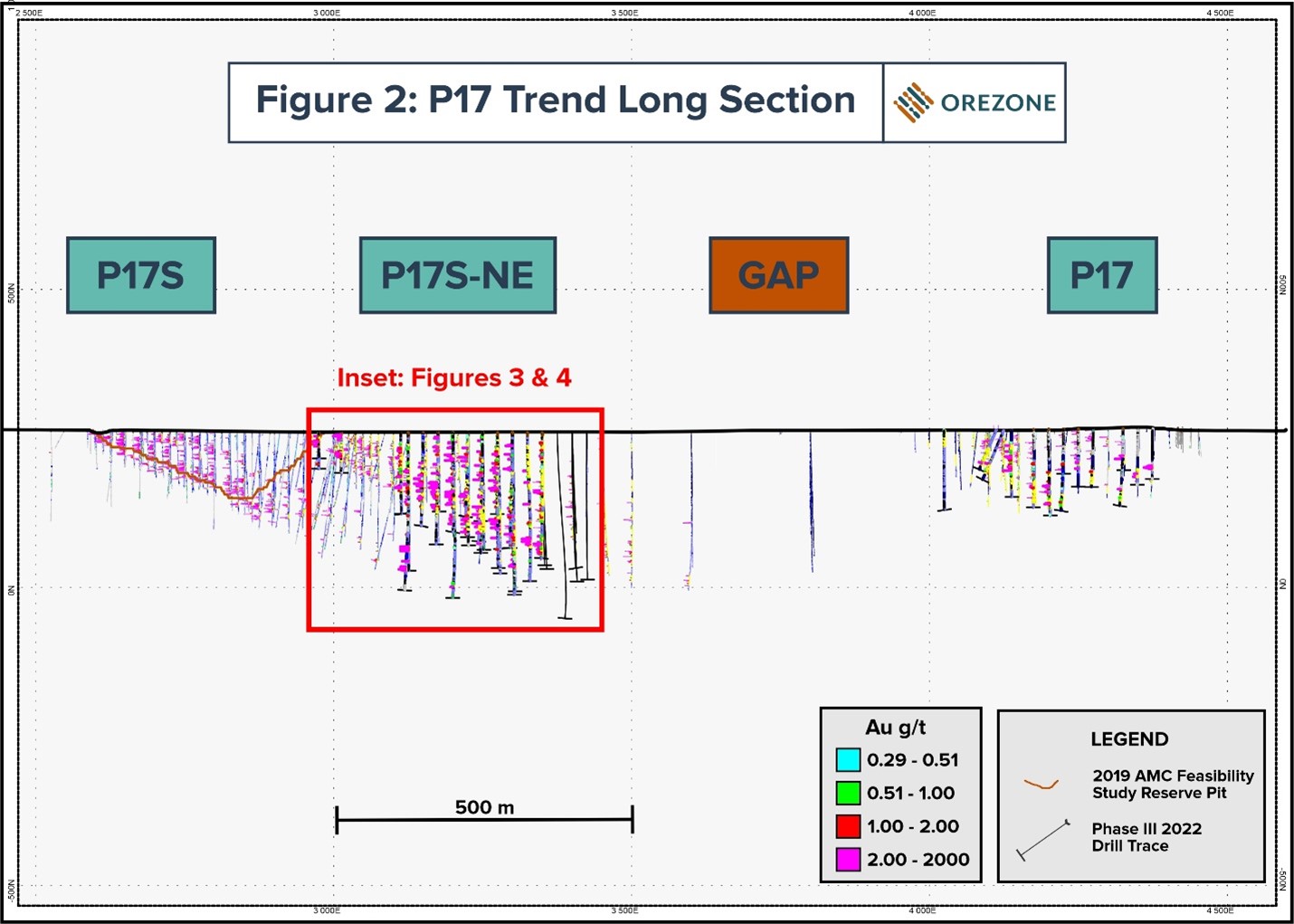
Figure 3: P17S Section 730280E – Pre 2022 Drill Programs
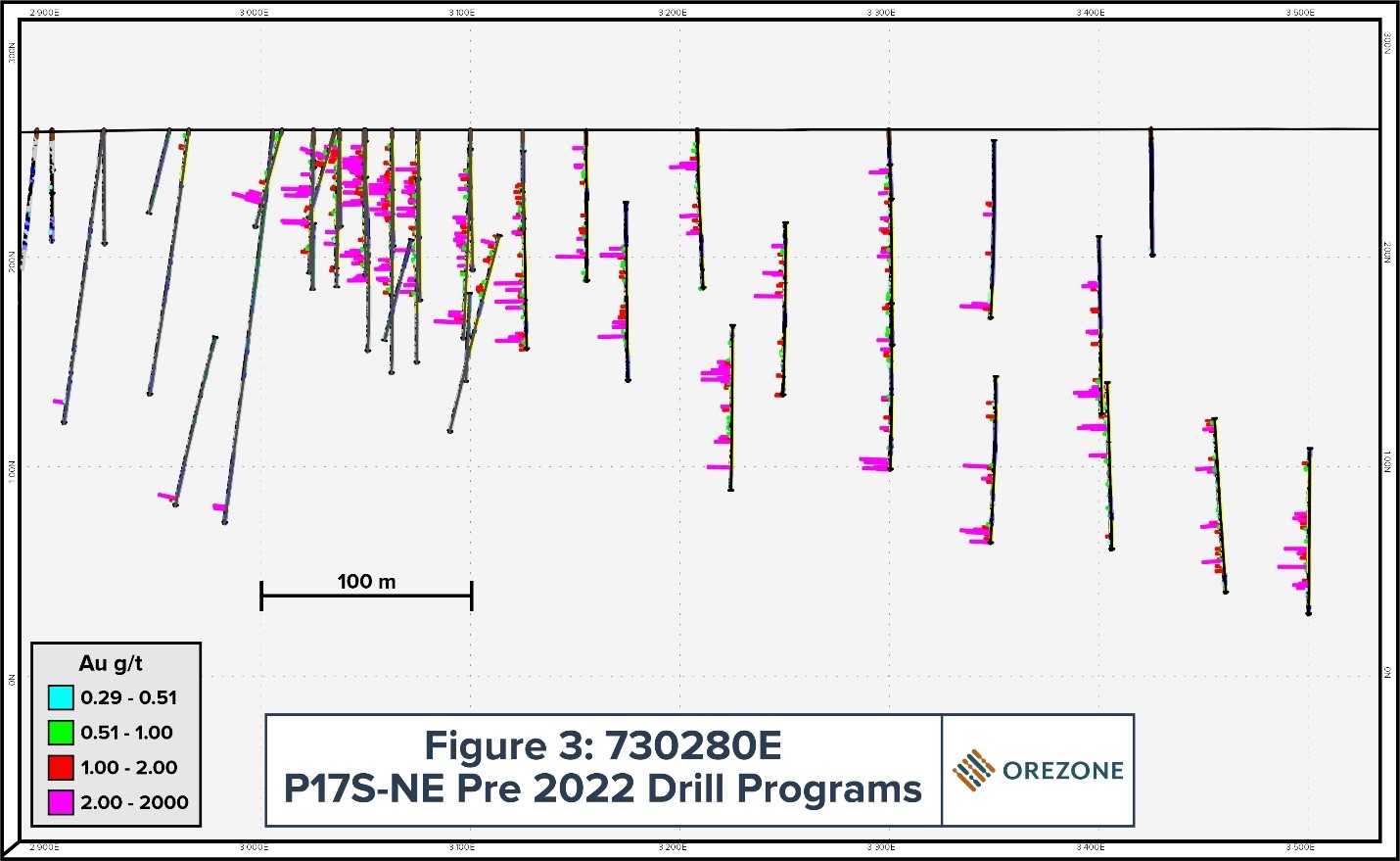
Figure 4: P17S Section 730280E – Drilling to Date
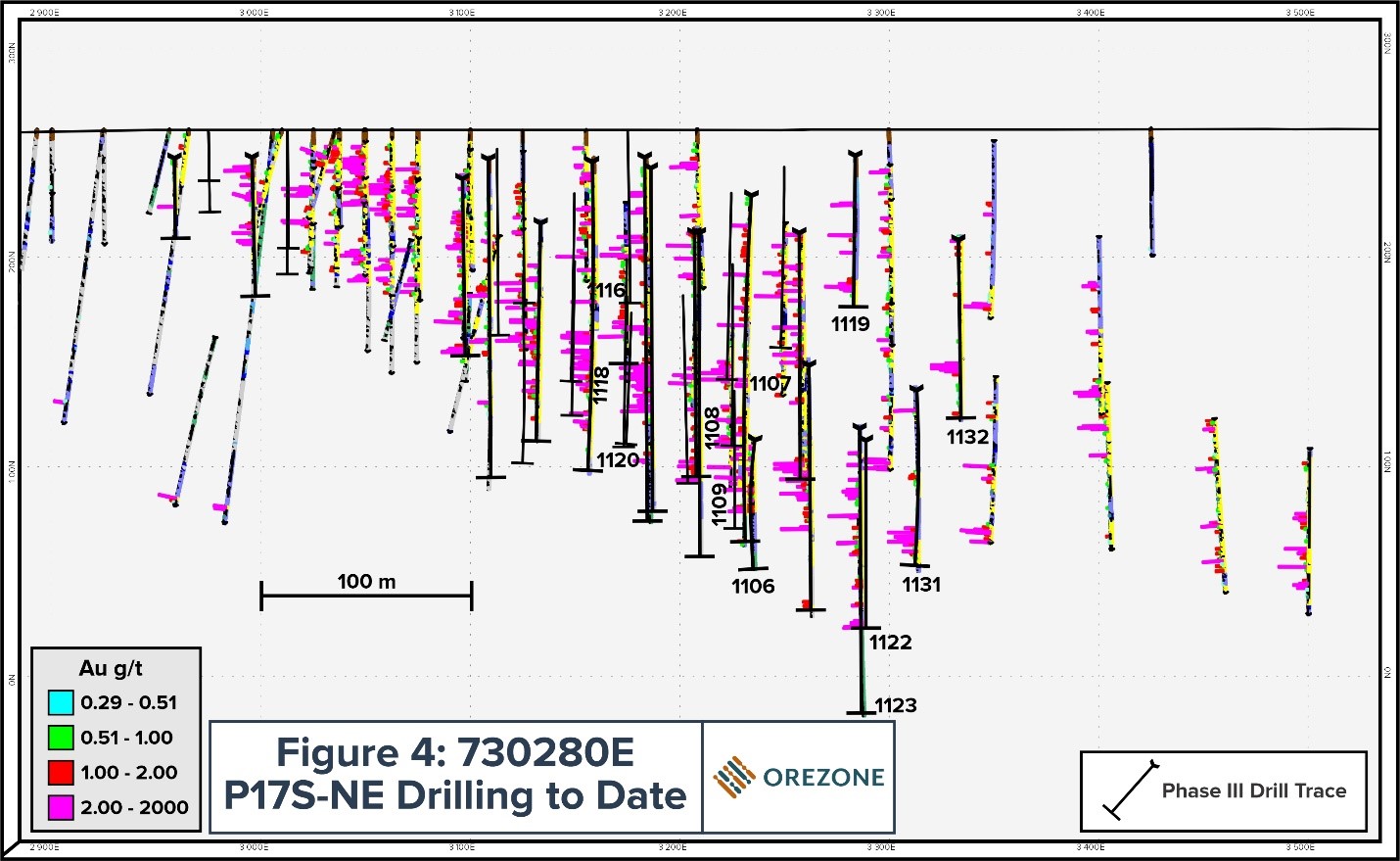
The above references an opinion and is for information purposes only. It is not intended to be investment advice. Seek a licensed professional for investment advice. The author is not an insider or shareholder of any of the companies mentioned above.
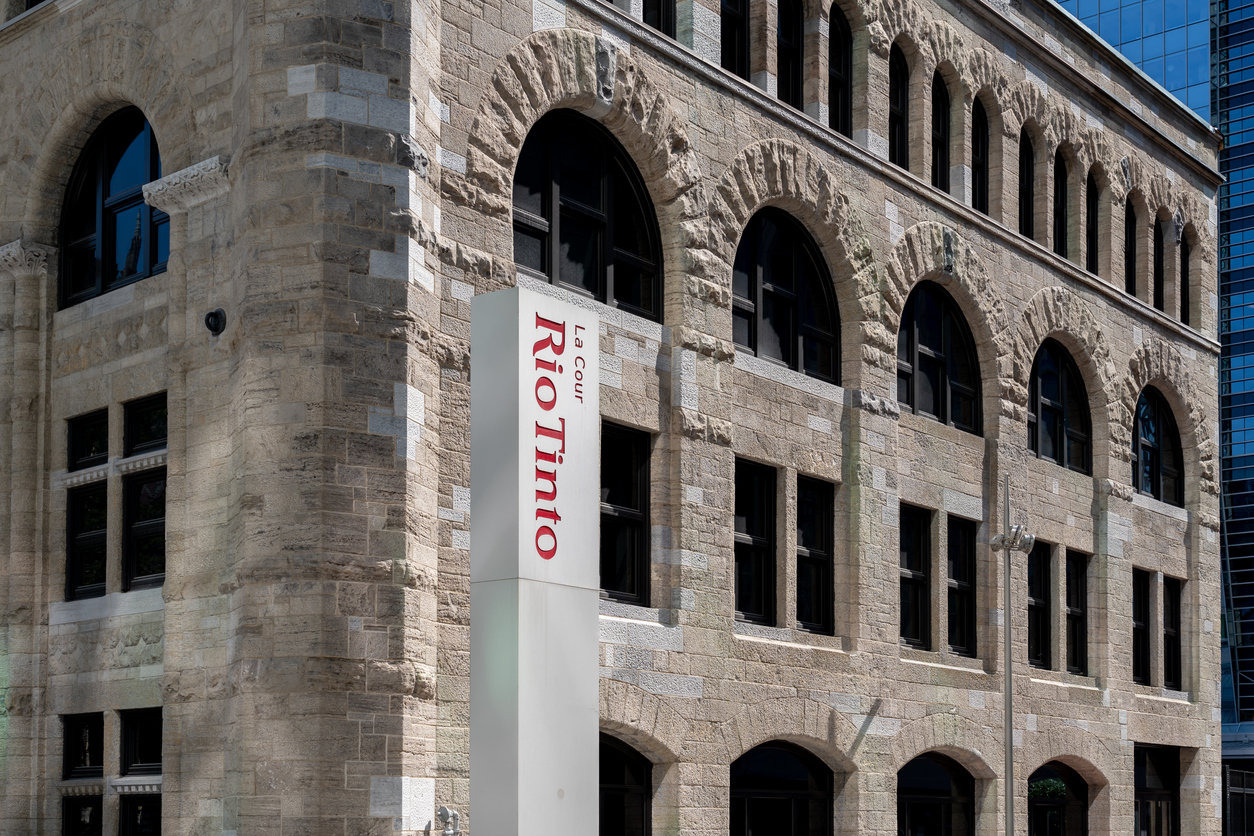
Mining companies are ramping up their investments in battery technologies and mining for battery metals. Due to the increase in electric vehicles and other battery-powered devices, the demand for these materials is expected to rise. Rio Tinto (ASX:RIO), one of the world’s largest mining companies, has invested $10 million in Nano One Materials, a Canadian company that is developing new battery technologies. The investment will be used to purchase the Candiac facility in Québec, and will give Rio Tinto a 4.9% stake in Nano One. Nano One will issue 4.6 million shares at C$2.70 in a non-brokered private placement.
Following the transaction, Nano One will acquire the Candiac facility in Quebec, Canada. The investment will also be used for working capital purposes, commercialisation, technology, and supply chain development. The investment represents a partnership that will go beyond just the purchase of the facility. The companies will study Rio Tinto’s battery metal products which include iron powders from its Fer et Titane facility in Sorel-Tracy, Quebec. Then Nano One will be able to use those iron powders as part of its feedstock to make cathode materials.
Nano One CEO Dan Blondal commented: “The global transition to a low-carbon electrified economy will require millions of tonnes of battery materials, so it is critically important to produce these materials efficiently and with the lowest environmental footprint. Rio Tinto’s partnership and support complement our recent announcement to acquire Johnson Matthey’s LFP business in the nearby community of Candiac, Québec and amplifies the Government of Canada’s Mines-to-Mobility initiative, which aims to encourage a localised battery ecosystem to serve the broader North American market.”
Rio Tinto will also be partnering with Nano One for its technical and business issues around design, development, construction, and operations at cathode facilities. Both companies bring expertise from both sides of the supply chain. In return, Rio Tinto is going to provide its expertise from the company’s Critical minerals and Technology Centre in the partnership, to support the manufacturing of cathode active materials in Canada.
Cathodes are a critical component of lithium-ion batteries and the use of Rio Tinto’s products will help Nano One to improve its performance and reduce the cost of its cathode materials. This is an important step in developing new battery technologies that can be used in a variety of applications, including electric vehicles.
Rio Tinto Battery Materials portfolio managing director Marnie Finlayson commented: “Localised, clean and secure supply chains are critical for the success of the energy transition that is now underway and this requires partnerships with innovative companies like Nano One to help us differentiate, disrupt and accelerate the path to a net-zero future.”
Partnerships like this one are essential to the development of new battery technologies and the growth of the electric vehicle market. With the increase in demand for these materials, it is important to have a secure and reliable supply chain. These types of partnerships will help to ensure that there is a steady supply of battery metals and that new technologies can be developed quickly and efficiently.
The above references an opinion and is for information purposes only. It is not intended to be investment advice. Seek a licensed professional for investment advice. The author is not an insider or shareholder of any of the companies mentioned above.
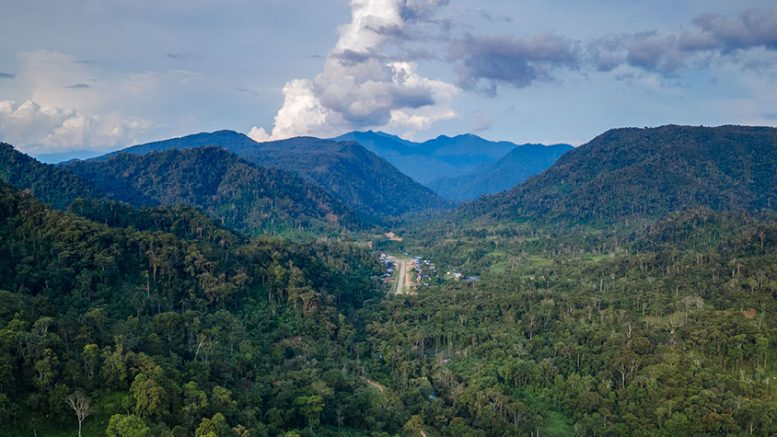
Solaris Resources (TSX:SLS) has announced an agreement with the Government of Ecuador that will secure the stability of its Warintza Project in southeastern Ecuador. The company has signed an Investment Protection Agreement that provides a foundation of certainty for the legal framework governing the Warintza Project. The agreement outlines further affirmation of stable mining regulations, security of title, and investment for the term of the agreement, on top of significant new tax incentives to accelerate development at the project.
Highlights from the agreement:
- The IPA provides a foundation of certainty with respect to the legal framework governing the Project, including stable mining regulations, security of title and investment, and new tax incentives to accelerate development
- 5% reduction of income tax, fixing the income tax rate at 20% (applicable to SLS), exemption from capital outflow tax, and exemption of all import duties for the import of goods needed for new investments
- Specific protections relate to the prohibition of all forms of confiscation, non-discriminatory treatment and equal playing field, legal security, tax stability and international arbitration
- IPA signing ceremony to take place with the Warints and Yawi communities at the Project in July. SLS recently amended its Impact and Benefits Agreement with these communities reaffirming their support for the responsible advancement of Warintza
Ms. Lorena Konanz, Vice Minister of Export and Investment Promotion of the Government of Ecuador, stated, “From day one, our administration has been focused on encouraging sustainable and transparent economic growth in Ecuador with incentives to facilitate major investments in the country. In the mining sector, our most important goal is to ensure that development is responsible, environmentally friendly, and socially-committed, as at the Warintza Project.”
Mr. Vicente Tsakimp, Coordinator of the Warintza Project Strategic Alliance, stated, “We are excited to be part of the successful advancement of Warintza and show the industry that it is possible to develop a mining project in a responsible and inclusive way. The people of Warints and Yawi welcome President Lasso’s approach which promotes the development of remote communities as this has had a direct impact on our families’ economy, living conditions and opportunities.”
Mr. Daniel Earle, President & CEO, commented, “President Lasso´s administration continues to take consequential action to accelerate the development of the formal mining sector in Ecuador. Its positive approach of regulatory reform and meaningful tax relief focused on major new projects like Warintza, which embrace responsible approaches to community development and environmental protection, will pay great dividends to the people of Ecuador for generations to come. We are humbled to operate in service of its vision.”
The agreement will include a 5% income tax reduction, fixing the total income tax rate applicable to Solaris Resources at 20%. There will also be an exemption from the capital outflow tax and all import duties for any import of goods needed for new investments in the Warintza project. The signing ceremony for the agreement will take place with the participation of the Warints and Yawi communities, two important community partners for the Warintza Project and Solaris, in the village of Warintza sometime in July 2022.
The other notable parts of the agreement are the specific protections related to the prohibition of all forms of confiscation, non-discriminatory treatment and equal playing field, legal security, tax stability, and international arbitration if there are any disputes about the Warintza Project. With countries like Peru experiencing upheaval in the mining industry and nationalization of resources and projects in Mexico, Ecuador and the communities of Warints and Yawi have shown that collaborative, collective work is not only possible, but the most beneficial form of business for all stakeholders.
The above references an opinion and is for information purposes only. It is not intended to be investment advice. Seek a licensed professional for investment advice. The author is not an insider or shareholder of any of the companies mentioned above.

Silver prices have swung to new highs as investors weigh risks and equity sell-offs. Prices have swung from trading over US$25 in March to hit a YTD high of US$26.38, and after a pullback at the end of that month, another price spike in April brought it back to those highs. From an April high of US$25.91, prices have hit a low of US$22.52.
However, despite the pullback, silver has begun to trade more like its safe-haven sibling gold. But while gold is often held as a hedge against risk and inflation, silver has applications beyond that. It’s used in solar panels, water filtration, and a variety of other industrial applications. So, while it may not be as popular as gold, it certainly has its place in a portfolio.
For investors looking for silver stocks, the current sell-off has provided opportunities to value plays with massive upside as silver prices rise again.
Honey Badger Silver (TSXV:TUF)
Honey Badger Silver, a junior mining company based in Canada, has had a string of announcements during silver’s turnaround. Most recently, the company announced on March 29 that it had acquired a 100% interest in the Clear Lake deposit in the Whitehorse Mining District of the Yukon.
The transaction is subject to a 1% net smelter return royalty on all metals except silver. The Clear Lake deposit is known to be an important source of zinc and lead but holds mostly silver. With the acquisition, Honey Badger Silver Inc. is becoming the owner of a historic resource of 5.5 million ounces of silver.
This acquisition was an important addition to Honey Badger Silver’s portfolio, as it works to enter more silver properties at different stages of production in order to allow it to offer investors high exposure to silver prices. The company continues to conduct asset evaluations.
The historical resources were reported in a NI-43-101 technical report dated February 23, 2010, and were 43-101 compliant at the time the agreement was signed.
Americas Gold and Silver (TSX:USA)
Americas Gold and Silver is based in North America and owns several producing sites, including the San Rafael mine in the Cosalá operations in Sinaloa, Mexico, which includes the Galena Complex from Idaho, US
During its quarterly earnings call on March 17, the firm revealed its complete 2021 results and addressed the disappointment seen at its Relief Canyon Mine, which failed to go into commercial operation in 2021 owing to metallurgical difficulties. The company is confident, however, due to the reopening of Cosalá and the rising silver price. Its most recent Q1 production results also showed an output of 300,000 silver ounces and 1,274,000 silver equivalent ounces.
New Pacific Metals (TSX:NUAG)
New Pacific Metals is a precious metals explorer and builder. Its main business at the moment is its Bolivian Silver Sand project, which it developed. The firm has two additional silver properties in Bolivia: Silverstrike and Carangas. New Pacific is exploring Silver Sand and Carangas for 2022.
New Pacific Metals released two news stories about exploration at Carangas in February: one announcing a grade of 78 grams per metric ton (g/t) silver and the other sharing the discovery of gold mineralization. However, until silver’s price surge in March, the company’s share price did not experience significant gains. In April, the company also announced intersections of 229 g/t silver at the Silver Sand project, and guidance that it expected to complete 15,000 meters of drilling by the end of April.
The above references an opinion and is for information purposes only. It is not intended to be investment advice. Seek a licensed professional for investment advice. The author is not an insider or shareholder of any of the companies mentioned above.

Honey Badger Silver (TSXV:TUF) announced on May 16, 2022, that a 10-year class 3 quartz mining land use approval has been granted by the Yukon Government in Canada at the high-grade Plata Silver Property. Honey Badger will be allowed to perform ground exploration activities for up to 300 diamond drill and 300 reverse circulation holes, for a total length of 30,000 metre, significant trenching and bulk sampling, and road construction to be able to define areas of mineralization on the property.
Exploration permits are critical in order to continue the development of a project and without them, a company is unable to move forward. This is a significant milestone for the company as it can now focus on moving the project toward high-grade discoveries and development.
Chad Williams, Chairman of Honey Badger Silver, commented in a press release: “Plata has produced high-grade silver from small-scale mining in the past and currently hosts 32 showings(1), many of which have returned high-grade silver, lead and zinc values, from drilling and trenching. We are looking forward to unlocking the extraordinary potential we believe Plata possesses.”
Honey Badger Silver also recently announced it had acquired a 100% interest in the Clear Lake Deposit, in the Whitehorse Mining District in Yukon. The acquisition was another critical step for the company toward its strategy of entering more silver properties with high optionality at different stages of production to allow it to offer investors high exposure to silver prices.
The above references an opinion and is for information purposes only. It is not intended to be investment advice. Seek a licensed professional for investment advice. The author is not an insider or shareholder of any of the companies mentioned above.
Trillium Gold Mines (TSXV:TGM) has begun its comprehensive exploration program on its recently-consolidated Confederation Belt Project. From the separately held properties, the company has consolidated them into one 54,362-hectare, contiguous land package that spans 72 kilometres from east to west. Crews are mobilizing, and work has begun on the project. The Confederation Project is not just the company’s most significant project – it is the most significant exploration project in the Red Lake District. It has the potential to contain further Dixie LP Fault analogues, other Red Lake-style gold mineralization and critical minerals.
Trillium has initiated early exploration permit applications for drilling and trenching, and the company expects to receive them sometime in early summer 2022. The company has planned an initial 6,000 metres of drilling throughout the project area for targets that have already been systematically researched, prioritized, and deemed drill-ready. It will consider further drilling once results from the exploration are received.
Russell Starr, President and CEO of Trillium Gold commented in a press release: “Our strategy to consolidate the Confederation belt properties has positioned Trillium Gold as the dominant exploration company in the Red Lake District today. Many former VMS-rich districts are well endowed with gold, and the Dixie LP Fault deposit, lying on the same stratigraphic trend as Trillium’s contiguous claim block, is possibly another example. A large portion of the property is accessible via long-standing logging roads. We believe we are at the nexus of a new era in this rapidly developing gold camp.”
William Paterson, Trillium Gold’s Vice President of Exploration also commented: “Our geological team has now begun the exploration work with reconnaissance traverses, drill hole sighting and ground-truthing of work performed by previous operators. We have an unprecedented opportunity to explore for LP Fault-type gold deposits along a structure that is many times larger and equally as prospective as Dixie.”
Some important attributes of the property include:
- Over 110 linear kilometres along the eastern extensions of both the major crustal Red Lake and Dixie LP Fault structures.
- Several high-potential mafic-to-felsic structural contacts on-strike to the east of the Kinross Dixie Project associated with the eastern continuation of the LP fault zone.
- The Panama Lake portion of the property shows gold potential in three identified zones while further compilation work has identified other structural and lithological dislocations that warrant priority follow-up work.
- Other high-potential areas to be tested along the northern margin of the Project area, associated with the major structure hosting Evolution Mining’s Red Lake Operations.
- Demonstrated gold and historic base-metal deposits; importantly, strategic metal occurrences will be additional target elements for exploration in 2022.
- Comprehensive data collection, compilation and interpretation have generated many gold and base-metal targets for follow-up in the 2022 exploration program.
Figure 1: Trillium Gold’s Confederation Belt Project showing areas of focus for 2022 and planned activities, selected 2021 exploration results, and major structures (some interpreted). Geology from Geological Survey of Canada.
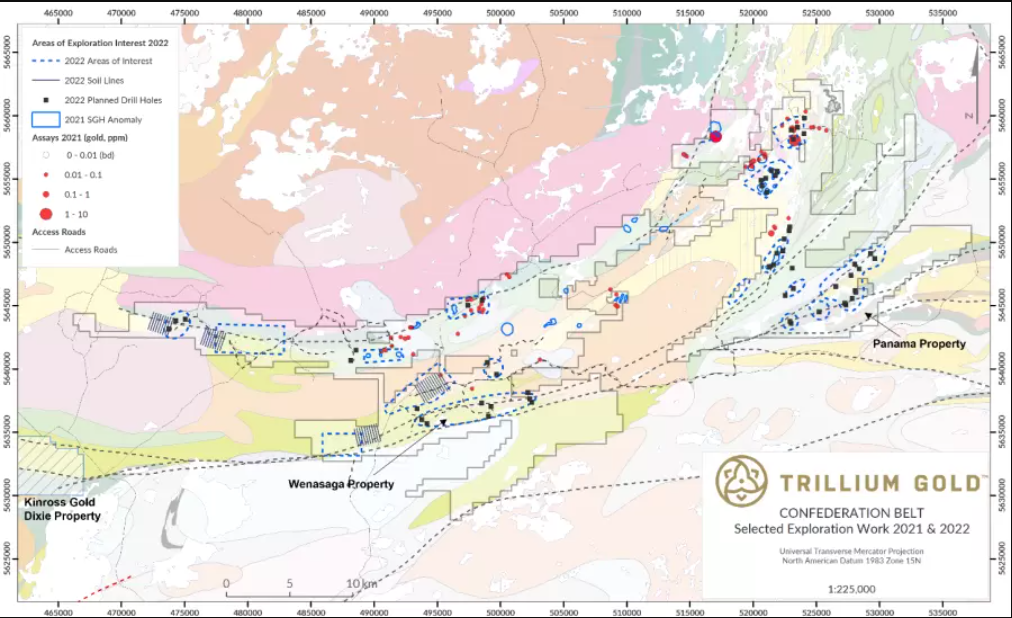
Throughout the Confederation Belt property, work will be performed to follow up on the high priority SGH anomalies from 2021. This planned work includes further soil sampling, lithogeochemical sampling and assaying of historical drill holes that were never previously assayed for gold (this is a very cost-effective activity where historical base-metal focused drilling has already been performed in those areas identified as having high gold potential). Systematic prospecting and mapping programs across the Project area are designed to explore for new deposits and further follow up on results from the 2021 field work (Figure 1).
Geology & Mineral Potential
The geology throughout the Project area shows several features key to gold mineralization: felsic-intermediate volcanic and volcaniclastic rocks, mafic to felsic transitions, iron formations and chemical sediments, unconformities, large regional structures with known association to gold mineralization (e.g. the Dixie Project and Red Lake Mine), and, locally, on lower-order structures, complex structurally prepared ground that focus fluid flows and develop mineral deposits.
The Company’s exploration work and results from 2021 combined with exhaustive compilation work of historical data recently acquired, have identified several prospective areas hosting a variety of styles of gold targets including elevated gold content coincident with volcanogenic massive sulphide alteration halos. Often these halos are associated with structures and prospective lithology, suggesting the possibility of a later-stage gold enrichment mechanism or hybrid-style signatures.
A key area of focus will be the recently acquired Wenasaga Property, spatially associated with a dilation zone identified on the LP Fault extension. This deep-rooted structure would provide a conduit for gold-bearing fluids and the dilation zone creates the conditions for this gold to be deposited, whether rheological or chemically through widespread alteration. Preliminary work has already begun on this portion of the property.
Further east, the Panama Property contains two highly prospective gold-mineralized trends that remain largely untested. Major structures that transect the property appear to be splays from or are the eastern extension of the Dixie LP Fault. There are multiple gold and VMS-style mineralization occurrences identified on the property and a field program has been designed to expand on and evaluate the lateral continuity of these mineralized trends.
Figure 2: Trillium Gold’s Confederation Belt, Satterly Lake and Swain Lake Projects with major faults shown (some interpreted). Geology from Geological Survey of Canada.
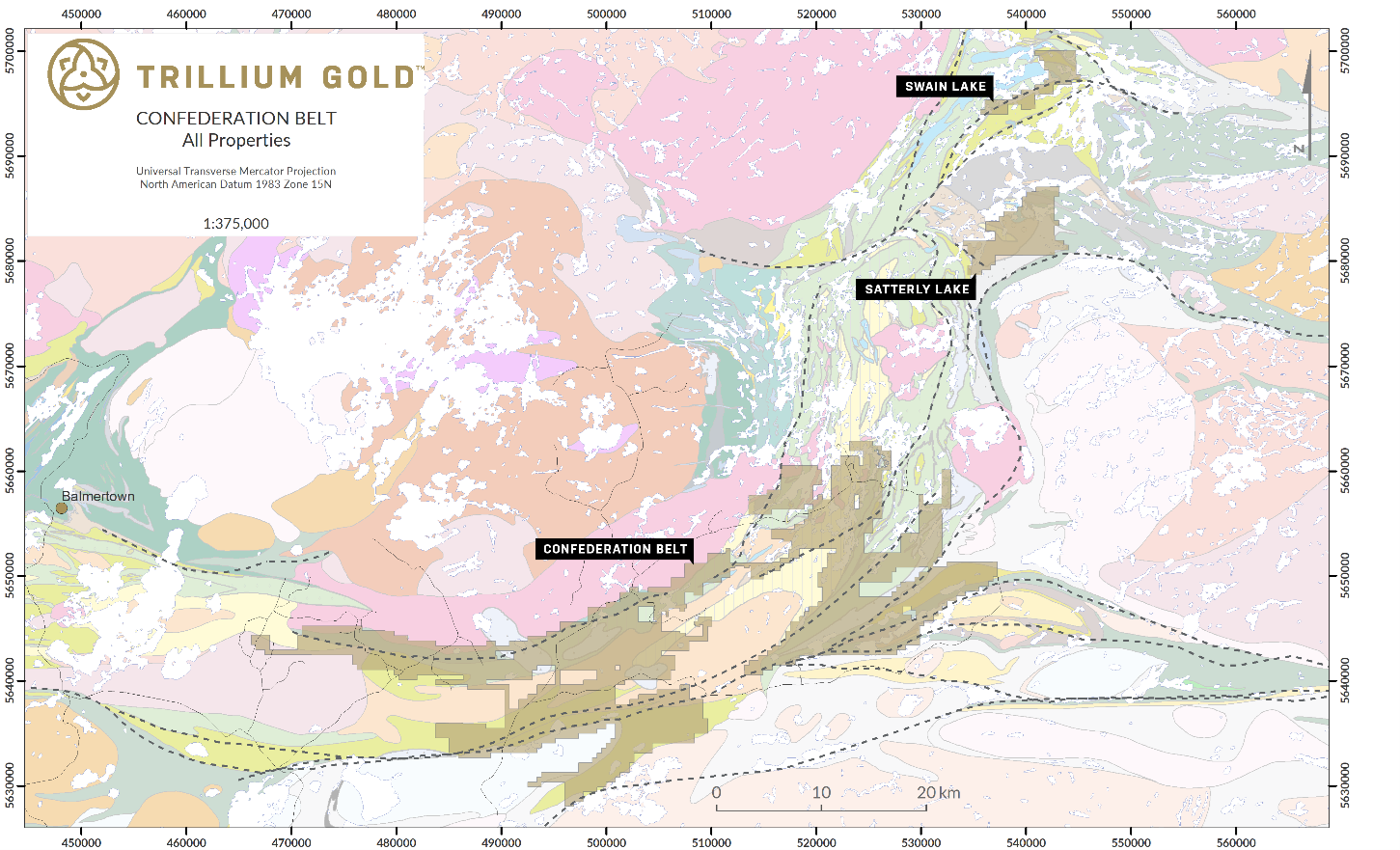
Satterly Lake and Swain Lake
These properties, located approximately 20 km and 35 km northeast of the Confederation Project and 90 km east of Red Lake, host structural, lithological and geophysical features important to gold mineralization (Figure 2). Initial field work will be performed on these projects utilizing floatplane-supported remote camps and will consist of prospecting and sampling. Historically, there has been little ground-based work performed on these properties. Trillium flew a high resolution helimagnetic survey over the then-current Satterly Lake property in 2021.
The Satterly Lake property is relatively unexplored, but several mineral occurrences are documented in the area. The Hanson (Au) and Loydex (Cu/Zn) occurrences are found on the property, the past producing Sol D’Or Mine (ore grading 19.2 g/t Au) lies immediately west and Falcon Gold’s Springpole West property to the east, with a diamond drill hole intercept of 19.4 g/t Au over 30cm within a property-wide fault zone hosted in a quartz vein-stockwork system.
The Swain Lake property encompasses a nine-kilometre stretch of the Swain Lake Deformation Zone (SLDF), over a gentle flexure point where the strike changes from a northeast trend to more easterly. Numerous gold occurrences are documented along the strike of this regional-scale structure. The property is located 8 km northwest of First Mining’s Springpole Lake property, which is reported as one of the largest undeveloped gold projects in Canada (Preliminary Economic Assessment, completed in November 2019, reported an Indicated Resource of 4,670,000 oz of gold and 24,190,000 oz of silver).
Within a six-kilometre radius of the Swain Lake property there lies the Argosy Mine (101,875 oz Au produced), the Richardson Lake Mine (1,126 oz of gold produced grading 60.7 g/t Au with an unclassified historical resource of 140,051 oz Au published in the Northern Miner [June 20, 1988]), the MacIntyre Mine reported to have produced 23 oz of gold in 1934-35 and First Mining’s Horseshoe Island prospect with a historical unclassified resource of 125,093 oz Au (OGS MDI record 52N08NW00020).
Source: Trillium Gold Mines
The above references an opinion and is for information purposes only. It is not intended to be investment advice. Seek a licensed professional for investment advice. The author is not an insider or shareholder of any of the companies mentioned above.
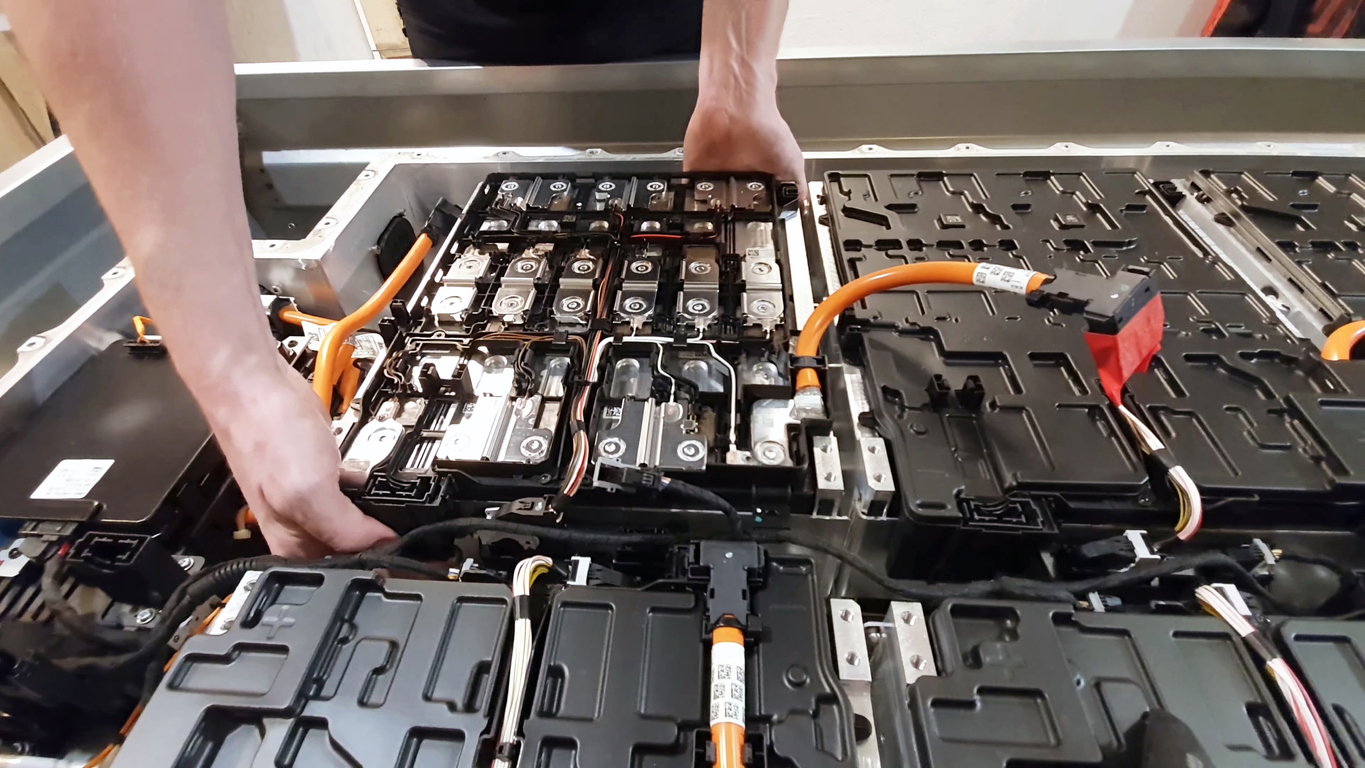
The Toronto Stock Exchange has launched a new battery metals index, allowing investors to track Canadian-listed companies involved in the production and exploration of metals used for battery manufacturing. Common battery metals include lithium, cobalt, and nickel.
Beyond tracking some of the biggest battery metal producers, the index will promote the growth of the critical mineral sector. Investors will also be able to gain insights into the energy transition and which companies are involved in the supply chain of this important industry. For Canada, this is an important index for its overall weighting. Companies involved in critical and battery minerals represented a quarter of the total equity capital raised by the mining sector for the TSX and TSXV. The mining industry in Canada is worth billions annually and is a significant contributor to the country’s GDP.
Some of the biggest entrepreneurs in the world have sounded the alarm about the supply/demand issues plaguing the industry. Elon Musk has called for more nickel production, even going so far as to say that Tesla has not ruled out acquiring mining companies and other assets to promote production. Metals like copper, nickel, and other battery minerals like lithium and cobalt are required to support the net-zero goals for global economies, particularly for battery storage from energy generation and electric vehicles.
Loui Anastasopoulos, CEO, TSX and Global Head, Capital Formation, commented: “In keeping with our long history of supporting the growth of the critical minerals industry and the interrelationship with clean technologies, decarbonisation, renewable energy and vehicle electrification, we are pleased to announce the launch of the new S&P/TSX Battery Metals Index. Global demand for battery metals continues to gain momentum and the goal of this new benchmark is to provide investors increased exposure to, and deeper insights into, the cleantech and energy transition story. TSX remains focused on the future, committed to working with our clients and industry stakeholders to seek innovative ways to enable the success of traditional and newly-defined sectors across our diverse and ever-evolving public markets ecosystem.”
The biggest constituents of the S&P/TSX Battery Metals Index will be:
- TRQ: Turquoise Hill Resources Ltd.
- TECK.B: Teck Resources Ltd Class B Subordinate Voting Shares.
- SMT: Sierra Metals Inc.
- FM: First Quantum Minerals Ltd.
- LUN: Lundin Mining Corp.
- ERO: Ero Copper Corp.
- HBM: Hudbay Minerals Inc.
- CGG: China Gold International Resources Corp. Ltd.
- CMMC: Copper Mountain Mining Corp.
- TKO: Taseko Mines Ltd.
The above references an opinion and is for information purposes only. It is not intended to be investment advice. Seek a licensed professional for investment advice. The author is not an insider or shareholder of any of the companies mentioned above.
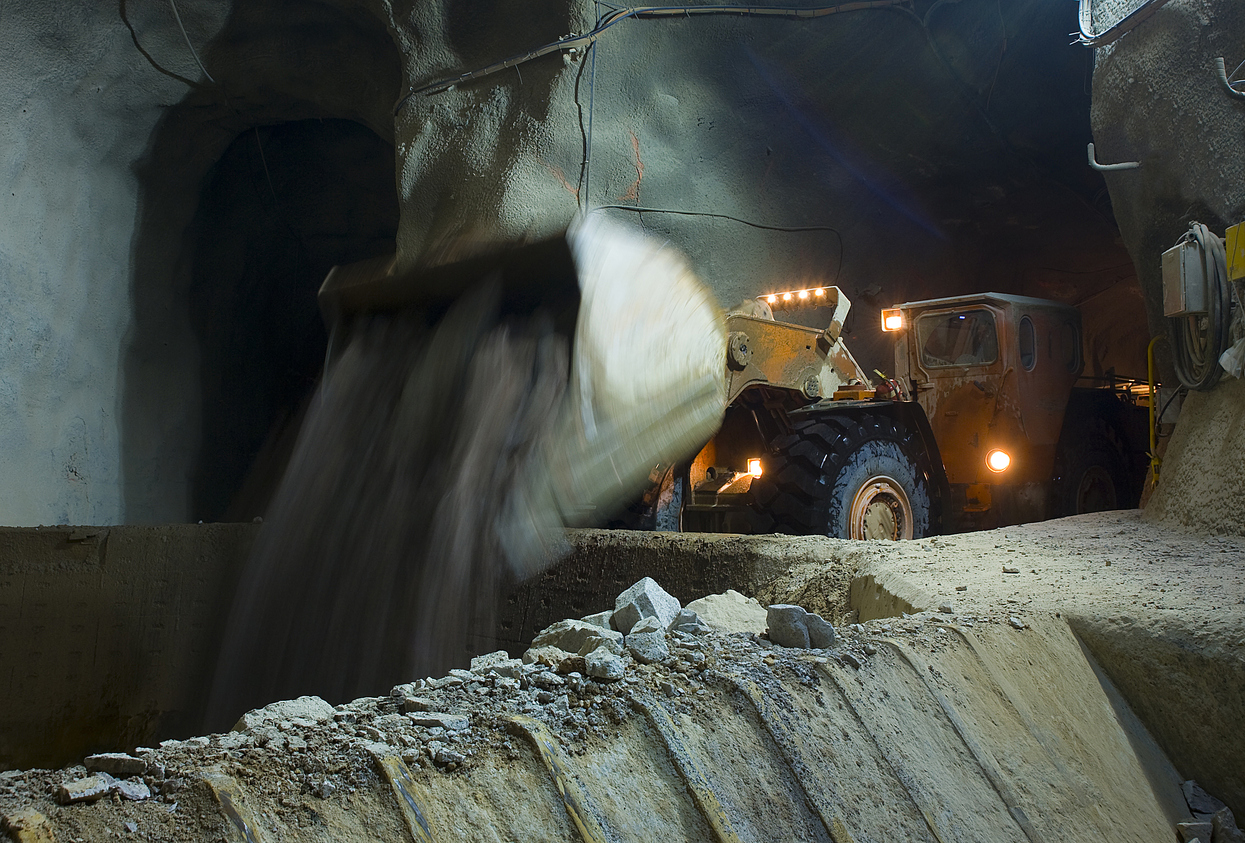
Focus Minerals (ASX:FML), an Australian gold mining company, has received permission for its mining initiative for the Greenfields open-pit operation from the Western Australian Department of Mines, Industry Regulation and Safety (DMIRS). The company is now cleared to begin mining at the Greenfields site, with ore produced being sent to Focus’ Three Mile Hill treatment plant for processing.
Greenfields is part of the Coolgardie Gold Project. Coolgardie is 175km2 of highly prospective tenements outside of the Coolgardie township in Australia. It is located 400m east of the Three Mile Hill Plant, making it accessible and efficient for transportation, and approximately 3.8 kilometres northeast of Coolgardie.
Now, Focus is trying to finalize ore reserves to include them in the new life of mine plan that will encompass Brilliant South, CNX, and Greenfields open pits. Focus will also search for a mining contractor due to the demand and supply conditions in Western Australia creating instability for stable resourcing.
The company has changed the project by optimizing the open-pit mine design using new contractor rates. This is in an effort to improve mining economics for the Greenfield deposit compared to the 2020 pre-feasibility study that was conducted.
Gold mining in Australia is a significant primary industry and contributor to the Australian economy. Many of the world’s gold reserves are found in Australia, and Coolgardie is one of the oldest goldfields.
Focus executive chairman Wanghong Yang commented: “This is a strategic milestone for Focus and its operations team. Greenfields is the starter open pit ore source in our resumption of the mining plan for Coolgardie. The approval of this mining proposal provides greater certainty for Focus as we target mining and ore stockpiling from early CY2023.”
The above references an opinion and is for information purposes only. It is not intended to be investment advice. Seek a licensed professional for investment advice. The author is not an insider or shareholder of any of the companies mentioned above.
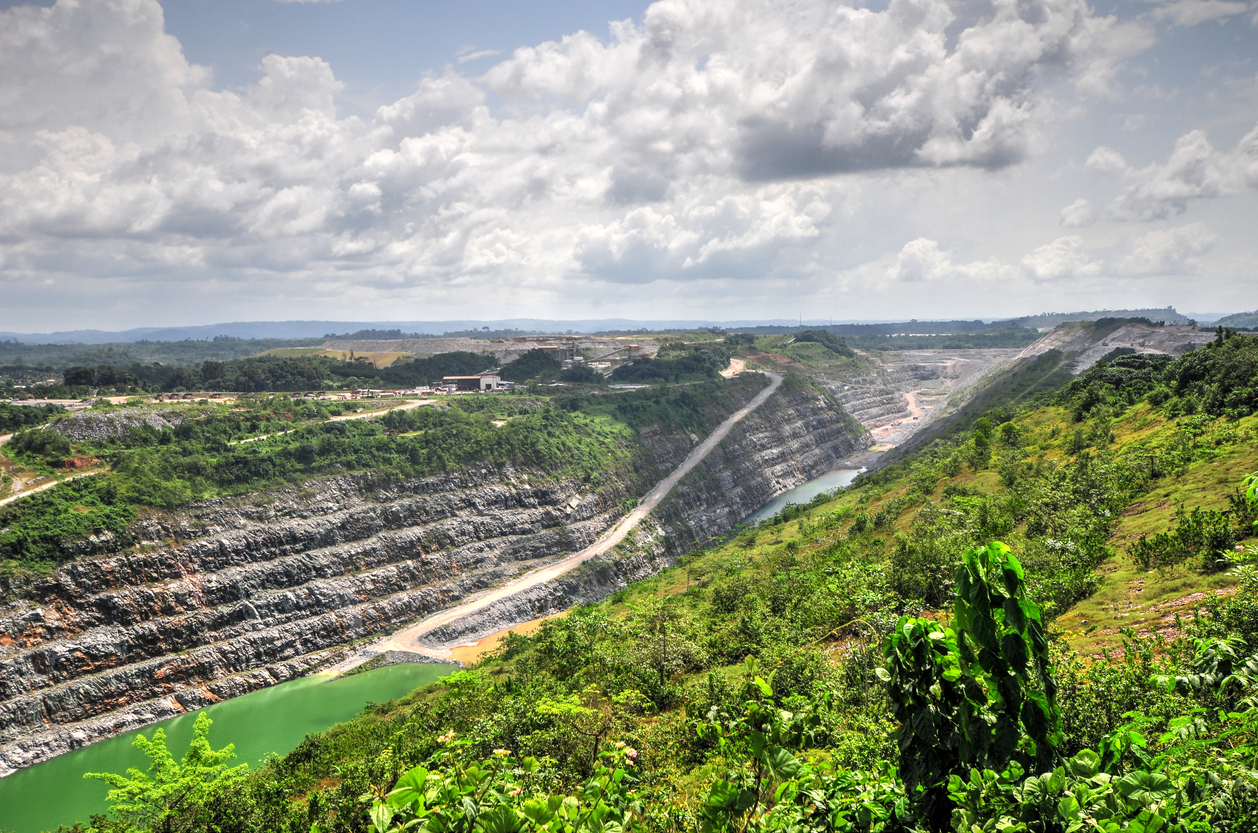
Asante Gold (TSXV:ASE) has announced it has begun operations at its processing plant at the Bibiani gold mine, located in Ghana. The mine was acquired in 2021 from Australia’s Resolute Mining (ASX:RSG) and will now become a 24-hour operation once a trial period is completed. The company will conduct a 14-day evaluation period so it can control and calibrate all the operating systems and align any critical equipment “under full load”.
Production goals for the mine include 175,000 ounces of gold for the first 12 months, increasing to 220,000 ounces annually in the second year, and finally 200,000-255,000 ounces annually from the third year to the eighth year. The past-producing mine has a mining program in place, currently with material movement at six million tonnes per month and with the expectation of a first gold pour by the third quarter of 2022. Asante Gold continues to incorporate stakeholders in the project, with strong ties to the country. Ghanaian citizens have a significant shareholding of the company and have roles on the board and in executive positions.
President and Chief Executive of Asante Dave Anthony commented in a statement: “We are pleased that our refurbishment efforts at the Bibiani Gold mine have been delivered ahead of schedule.”
Thanks to a feasibility study conducted by Resolute Mining and released in 2018, Asante understands it has the potential to produce 100,000 ounces of gold annually with a ten-year mine life. The all-in sustaining cost for production would be $764 per ounce.
Ghana’s gold mining industry has seen a revival in recent years, with new projects such as the Obuasi mine coming online. The country is Africa’s largest gold producer.
This project is not just a positive step for Asante, but for all shareholders and stakeholders. The company has taken a collaborative approach to its work in Ghana, bringing local communities and Ghanaians from around the country into projects and involving them in the process for the best possible outcomes.
The above references an opinion and is for information purposes only. It is not intended to be investment advice. Seek a licensed professional for investment advice. The author is not an insider or shareholder of any of the companies mentioned above.
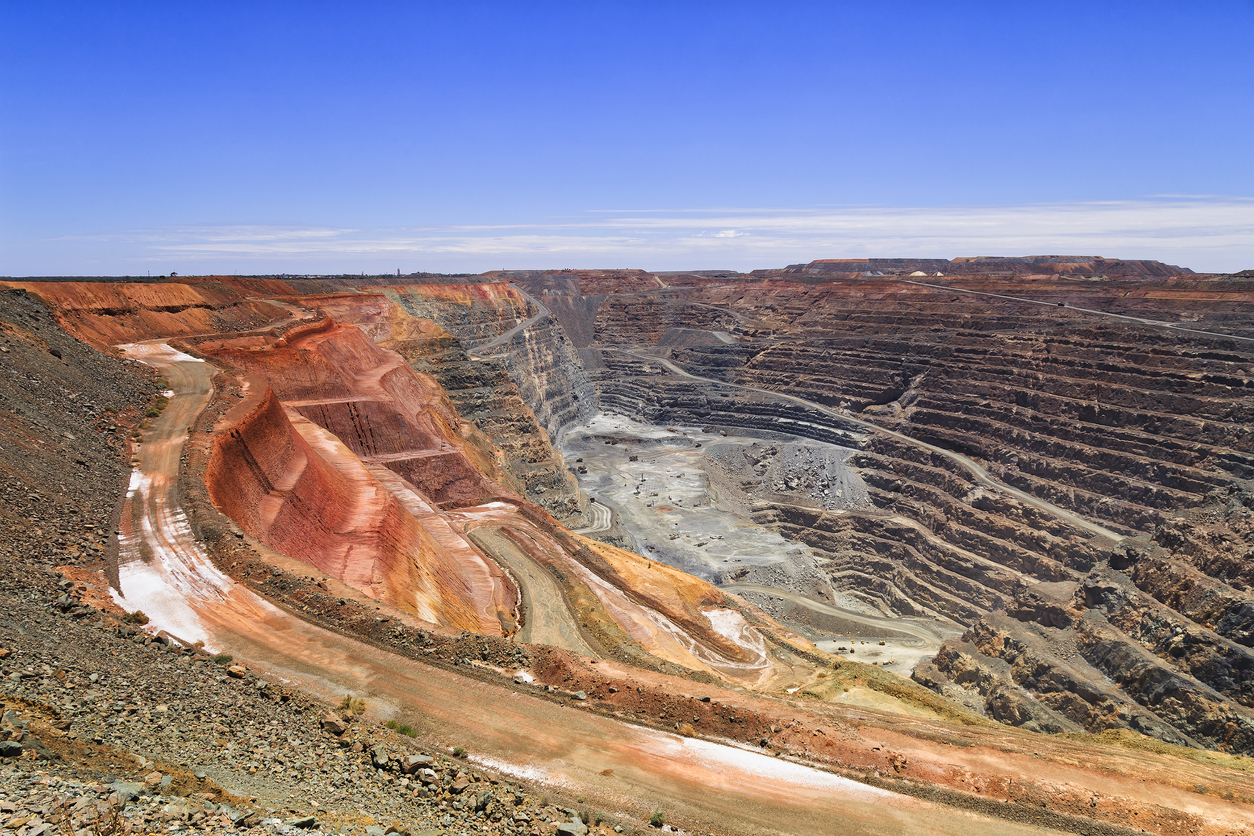
Gold Fields (NYSE:GFI) announced it will acquire Canadian gold mining company Yamana Gold (TSX:YRI), and will become the fourth biggest gold miner in the world once the acquisition is completed. For gold mining companies, the M&A process has become a way to increase gold production amid declining yields and fewer new discoveries.
The acquisition will give Yamana shareholders 0.6 of a Gold Field share per every outstanding Yamana Gold share. This is a 34% premium over its average share price from the past 10 trading days. The Yamana Gold board unanimously approved the deal that should close in H2 2022.
The combined company may see total production rise to 3.8 million ounces by 2024, once Salares Norte begins to come online and contribute to production numbers. That could make Gold Fields the world’s third-biggest gold miner according to the company’s CEO, Chris Griffith. In the coming decade, he also said the possibility of output reaching 4.8 million ounces is a possibility.
The merger, which will create a company based in Johannesburg, will have a market value of $15.9 billion. Gold Fields investors will own around 61% of the miner’s stock, while Yamana owners will hold the remaining 39%. Despite investors’ worries about populist policies and risks of higher mining taxes in neighbouring countries, the acquisition is consistent with Gold Fields’ desire to expand across North America, particularly in the Southern Hemisphere.
In addition, the company’s asset portfolio includes the development-stage Wasamac project in Quebec, Jacobina gold mine in Brazil, Cerro Moro gold-silver operation in Argentina, and two early-stage projects in Chile. It also owns a 50% stake in Malartic, the largest open-pit gold mine in Canada.
Only one mine remains in its home base for Gold Fields, which operates in Australia, West Africa and the Americas — South Deep. Its portfolio includes three operations in Ghana: the Cerro Corona mine in Peru, and the Salares Norte project in Chile.
Gold mining has seen decreasing returns in recent years as high-grade deposits of the precious metal have proven more elusive. To counteract this, miners have looked to increase production through M&A and cost-cutting measures. One of the factors offsetting declining yields is a stable and rising gold price over the long run that has boosted prices for assets from juniors. The Yamana Gold acquisition represents a significant win for Yamana and Gold Fields shareholders over the long run, creating what could become one of the most important gold companies in the world.
The above references an opinion and is for information purposes only. It is not intended to be investment advice. Seek a licensed professional for investment advice. The author is not an insider or shareholder of any of the companies mentioned above.
Trillium Gold (TSXV:TGM) has signed a purchase and sale agreement to acquire the rights and title to the Panama Lake Property owned by St. Anthony Gold Corp. The project is located on the same structural trend as Kinross Gold’s Dixie Deposit, only 80 kilometres away, and extends Trillium’s dominant contiguous land package in the Confederation belt by an additional 9,882 hectares.
Figure 1: Map showing Trillium Gold’s Panama Lake Gold Project

The details of the agreement are as follows:
Pursuant to an assignment and assumption agreement to be entered into on the closing of the transactions contemplated by the Purchase Agreement (the “Assignment Agreement” together with the Original Option Agreement, the “Option Agreement”), among Trillium Gold and St. Anthony Gold, St. Anthony Gold will assign all of its rights and obligations under the Original Option Agreement to Trillium Gold. In addition, pursuant to the Assignment Agreement, Benton Resources Inc. (“Benton Resources”) will agree to consent to the assignment and will agree to register 100% of the Property’s title to Trillium Gold while retaining its 50% ownership interest in the Property until such time as Trillium Gold fulfils its option to earn 100% interest.
Terms of the Agreement
Pursuant to the terms of the Purchase Agreement, at closing, Trillium Gold will pay St. Anthony Gold, Cdn $500,000 in cash and issue 1,000,000 common shares in the capital of Trillium Gold (the “Common Shares”). In the event Trillium Gold acquires a 100% interest in the Property, St. Anthony Gold may cause Trillium Gold to exercise its Buy-Back Right under the Option Agreement (as further discussed below) to repurchase from Benton Resources one-half of the 2% Net Smelter Royalty on the Property and convey such repurchased 1% Net Smelter Royalty to St. Anthony Gold in exchange for a cash payment by St. Anthony Gold to Trillium Gold of $1,000,000.
Pursuant to the terms of the Option Agreement, in order for Trillium Gold to earn a 70% interest in the Property, it will pay to Benton Resources Cdn $100,000 in cash or the equivalent in Common Shares, based on the 10-day value weighted average price (“VWAP”) of Trillium Gold’s Common Shares traded on the TSXV prior to issuance by October 24, 2022, and complete $250,000 in exploration expenditures on the Project by April 24, 2023. Trillium Gold has the option to earn 100% ownership of the Property by paying Benton Resources a further $300,000 in cash or the equivalent in Common Shares, based on the 10-day VWAP of Trillium Gold’s Common Shares traded on the TSXV prior to issuance and complete $300,000 in exploration expenditures on the Project in each case by October 24, 2023. Benton Resources has the right to retain a 2.0% NSR on the Project, subject to the option of Trillium Gold to buy back one-half of such royalty (being 1.0%) for Cdn $1,000,000 (the “Buy Back Right”). In the event that Trillium Gold completes a NI 43-101 compliant resource estimate for the Property, Trillium Gold will issue to Benton Resources Common Shares with the amount of Common Shares issuable to be determined based on the number of ounces of gold in the NI 43-101 report and the market price of the Common Shares at the time.
The Common Shares of Trillium Gold issued under the Purchase Agreement will be subject to a four-month holding period from the closing date. The Purchase Agreement is subject to the approval of the TSXV and other applicable regulatory authorities.
Source: Trillium Gold Mines
The above references an opinion and is for information purposes only. It is not intended to be investment advice. Seek a licensed professional for investment advice. The author is not an insider or shareholder of any of the companies mentioned above.
If you would like to receive our free newsletter via email, simply enter your email address below & click subscribe.
CONNECT WITH US
Tweets
Tweet with hash tag #miningfeeds or @miningfeeds and your tweets will be displayed across this site.
MOST ACTIVE MINING STOCKS
Daily Gainers
 Lincoln Minerals Limited Lincoln Minerals Limited |
LML.AX | +125.00% |
      |
GCR.AX | +33.33% |
      |
CASA.V | +30.00% |
      |
AHN.AX | +22.22% |
      |
ADD.AX | +22.22% |
      |
AZM.V | +21.98% |
      |
NSE.V | +21.05% |
      |
DYG.V | +18.42% |
      |
AAZ.V | +18.18% |
      |
GLA.AX | +17.65% |

 Follow us on Twitter
Follow us on Twitter Become our facebook fan
Become our facebook fan








